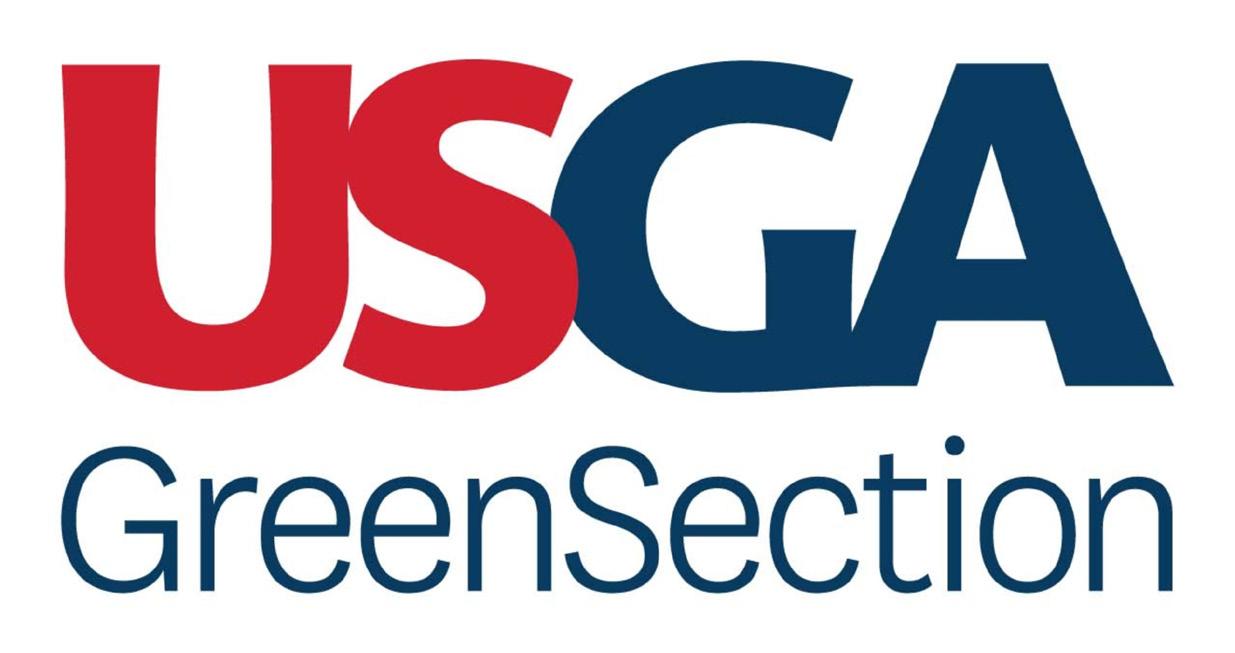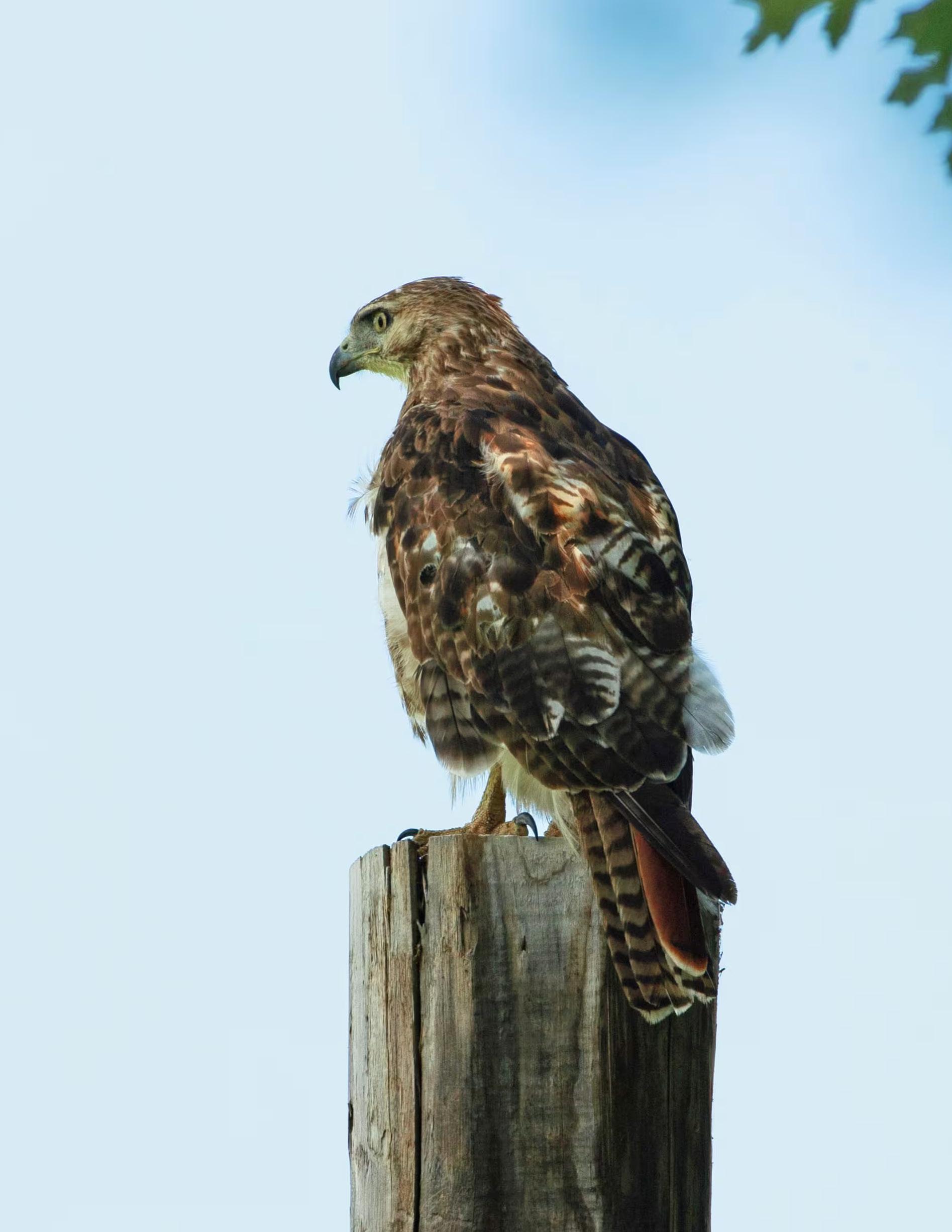

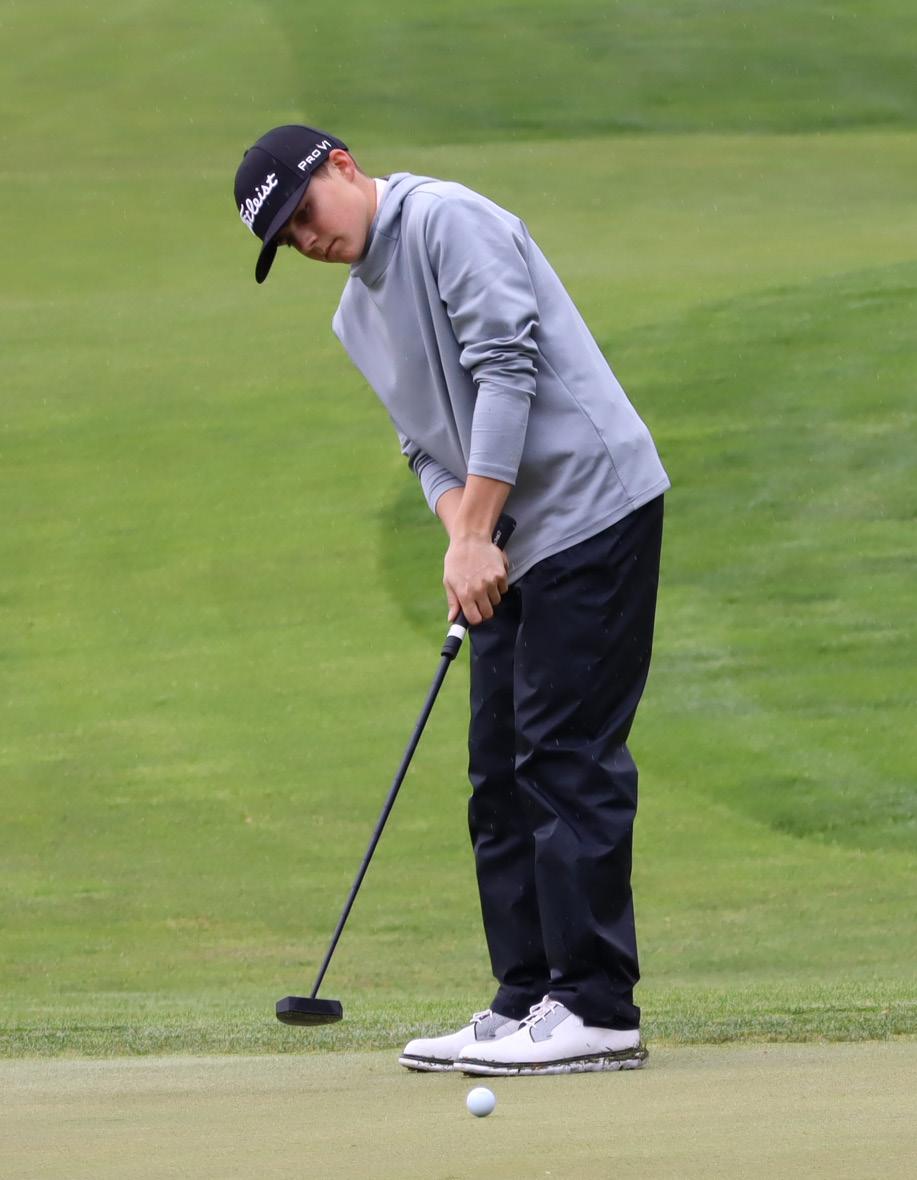




The Strength of The Montana Golf Community, Support Near and Far
Montana is a big place. You don’t need me to tell you that. From the peaks of the Bitterroots to the plains of Sidney, from prairie-inspired links on the Hi-Line to the tree-framed fairways of the Flathead Valley, our golf state stretches far and wide — and so does our collective passion for golf. But in a place this vast, what binds us together isn’t geography; it’s community.
You may have heard the cliché: “Montana is just a small town with really long streets.” What that means to me is less about pavement or dirt roads, but the fact that despite being the fourth largest state in land area, the population is smaller, and the reputations and connections run deep. Nearly everyone, knows someone in another town. Golfers in Montana understand that as well as anyone. We see it in parents driving hundreds of miles to get their juniors to an event and running into an old friend or relative of a classmate. We see it in the friendly handshake at the first tee from a volunteer starter or the congratulatory nod on the 18th green from a past champion to the newly minted one. We desire connection and we pull for one another.
And that spirit extends well beyond our borders. Many of Montana’s most accomplished players, teachers, and golf professionals have taken their talents to new places — college programs, professional tours, golf facilities around the country. When they succeed, we feel that success as our own. Whether it’s a junior champion making a name on the national stage or a club professional representing Montana at a regional or national
2 - 406GOLF - OCTOBER 15, 2025
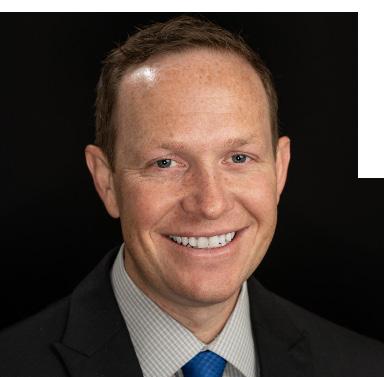
event, we follow, we cheer, and we take pride in knowing their story started right here at home.
There’s a special kind of connection that comes from being part of a statewide golf family. You might only see some of these faces once or twice a year, but when you do, there’s an instant familiarity — a shared understanding of where we come from and what this game means in the Big Sky. It’s a reminder that even in a sport defined by individual play, community is what gives it life.
We wrapped up our last golf events in September and while hard work has increased in preparation for next year, I’ve spent less time in the clubhouse and more time in the office. Perusing the various messages and news has made me excited not only about some of our high achievers on the national landscape, but the intense pride and support that our community has for our fellow Montana Golfers.
Recent examples are abundant you’ll read about a few in this issue – Max Milton, the talented junior from Polson earned high

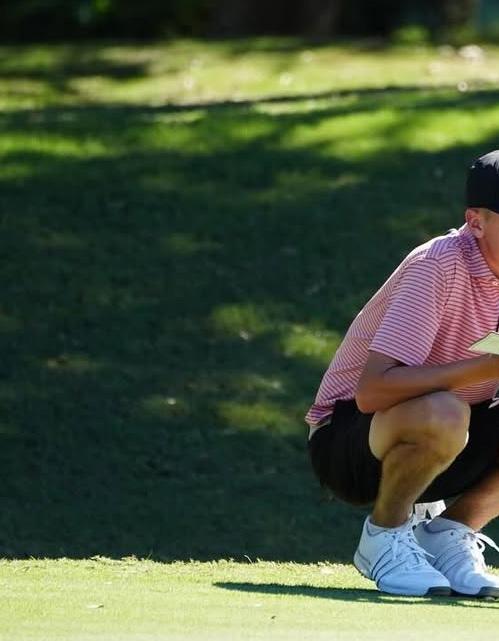
accolades on the AJGA from his exceptional play this year. John Gilbert, who I get to see more often in my hometown not only won a high school individual championship, the first since 1988 (Shoutout Rob Logsdon!) but more importantly made a commitment
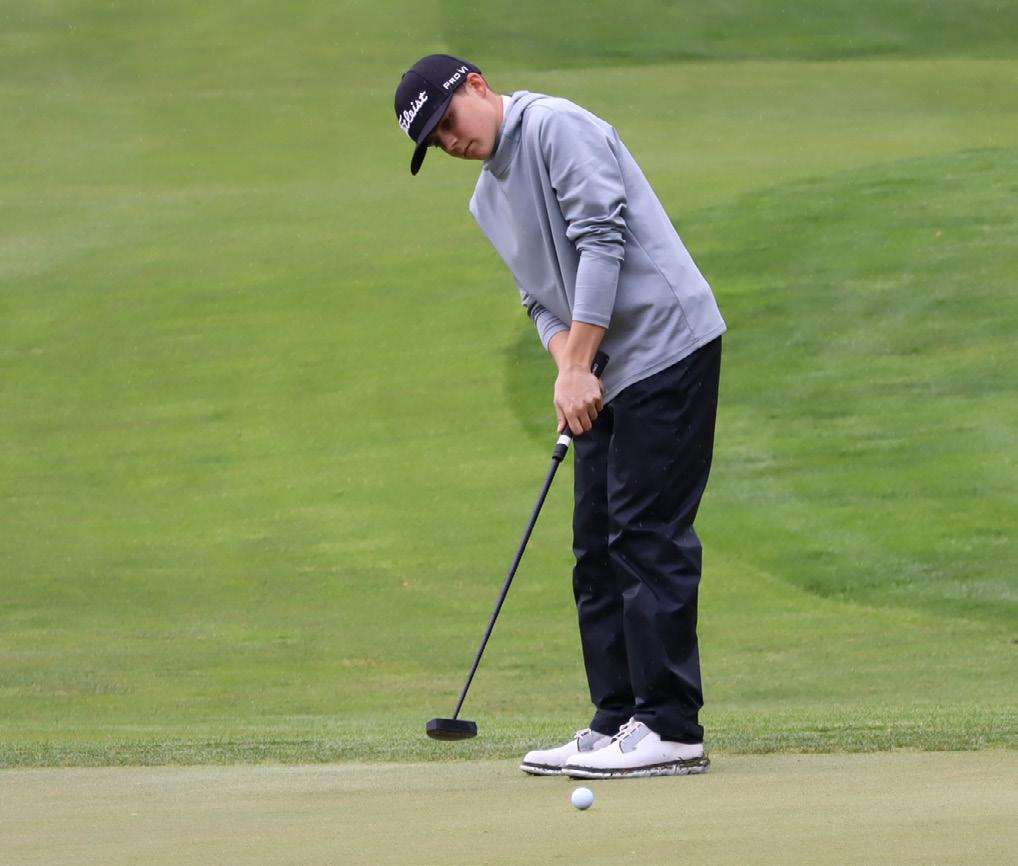

to Washington State to golf for the Cougars. Funny enough, but Rob also had Cougar golf ties once upon a time. It’s these connections that are rare enough and special enough that we hold them near and dear to our heart.
Jasi Somrock (Acharya) went on an incredible run through match play to advance to the quarterfinals of the 38th U.S. Women’s Mid-Amateur. Jasi, a former UM Grizzly
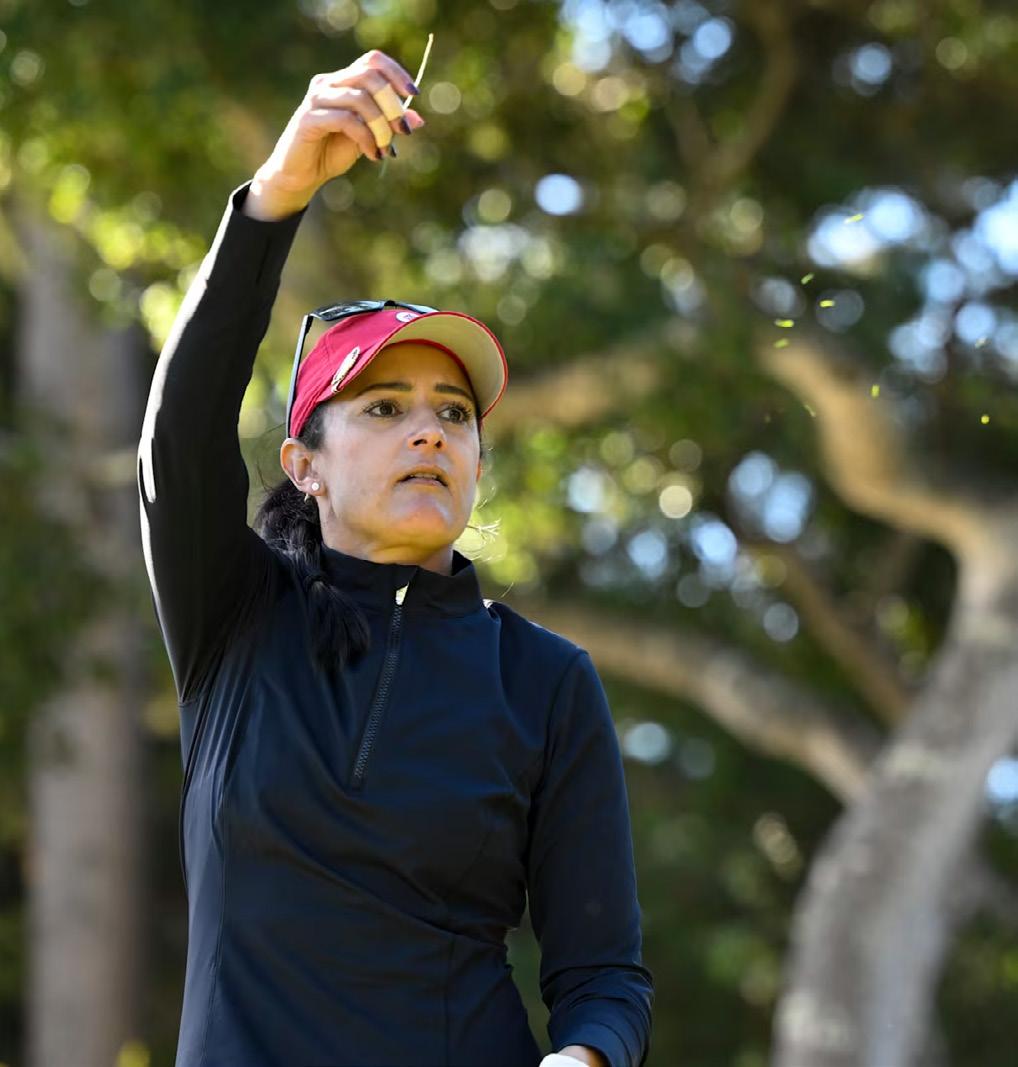
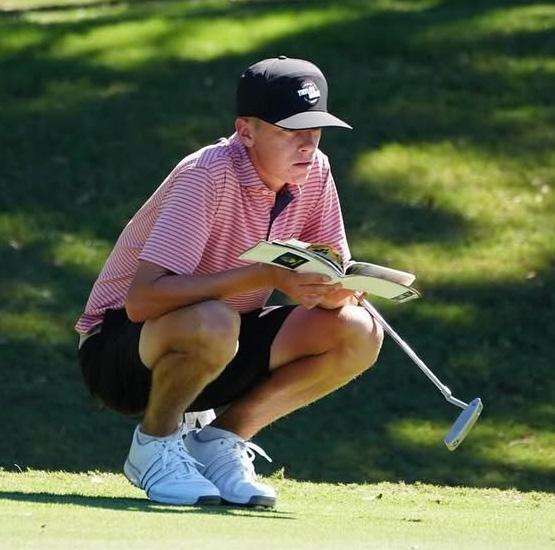
Golfer is now a Minnesotan and champion of the MGA in addition to her MSGA triumphs. We rooted her on and I had a few association friends ask what the tie was to Montana? I answered with the facts, but one quote summed it up better than I could:
“She’s Montana born/raised/educatedyou can probably claim her for the rest of her life.”
Our association’s work continues to be rooted in that belief. Every membership card represents not just access to a Handicap Index or a tournament, but participation in something larger — a network of players, facilities, and volunteers who make Montana golf what it is. When you renew, when you play, when you give back, you’re fueling that shared legacy.
As we look ahead, we’ll continue celebrating the achievements of Montanans who are making their mark elsewhere — because their stories inspire the next generation. And we’ll keep investing in programs and opportunities right here at home, ensuring that every golfer, from the high school standout to the weekend foursome, feels connected to this wider family.
Montana golf is as expansive as the land itself, but what truly makes it special is how small it can feel — how a community spread across thousands of miles can feel close, familiar, and proud of one another. Whether you’re teeing it up in Libby, Glendive, or somewhere far beyond like the Old Course (we see your Ryggs Johnston & Jonny Cielak), you’ll always have a home here in the Montana golf community.
So, to all who play, volunteer, coach, cheer, and represent our state wherever you go — thank you. You remind us that while Montana may be big, its heart is even bigger. Together, We Are Montana Golf!

PRESIDENT................................................... Peter Benson
VICE PRESIDENT.................................. Ron Ramsbacher
TREASURER....................................................... Bill Dunn
PAST PRESIDENT......................................... Mary Bryson
EXEC COMMITTEE......................................... Karen Rice
BOARD OF DIRECTORS
Peter Benson, Carla Berg, Mary Bryson, Bill Dunn, Cheri Ellis, Lisa Forsberg, Marcia Hafner, Ron Ramsbacher, Karen Rice, Joe Rossman, Rod Stirling
MSGA STAFF
Executive Director......................................... Nick Dietzen
Tournament Director...................................... Tim Bakker
Membership Operations Director............... Emily Hulsey
Member Services Coordinator......................... Ian Hulsey
Communications & Tournament Manager.... Katie Fagg
Communcations Coordinator.......................... Ty Sparing
Partnerships & Business Development...... Nick Dietzen
USGA PJ Boatwright, Jr. Intern................ Dean Hendrix
USGA PJ Boatwright, Jr. Intern...................... Ella Prigge
USGA PJ Boatwright, Jr. Intern................ Stella Claridge
Nick Dietzen.............................. 1 (800) 628-3752, ext. 6
406GOLF STAFF
Editor in Chief............................................... Nick Dietzen
Consulting Editor........................................ David Bataller
Senior Writer..................................................... Ty Sparing
Graphic Designer............................................... Katie Fagg
Contributing Writer...........................................Ella Prigge
Contributing Writer.....................................Dean Hendrix
Contributing Writer.........................................Bruce Scott
Contributing Writer.................Logan Groeneveld-Meijer
Contributing Writer..................................... Ross Niewola


Montana State Golf Association P.O. Box 4306 Helena, MT 59604
1 (800) 628-3752
www.msgagolf.org



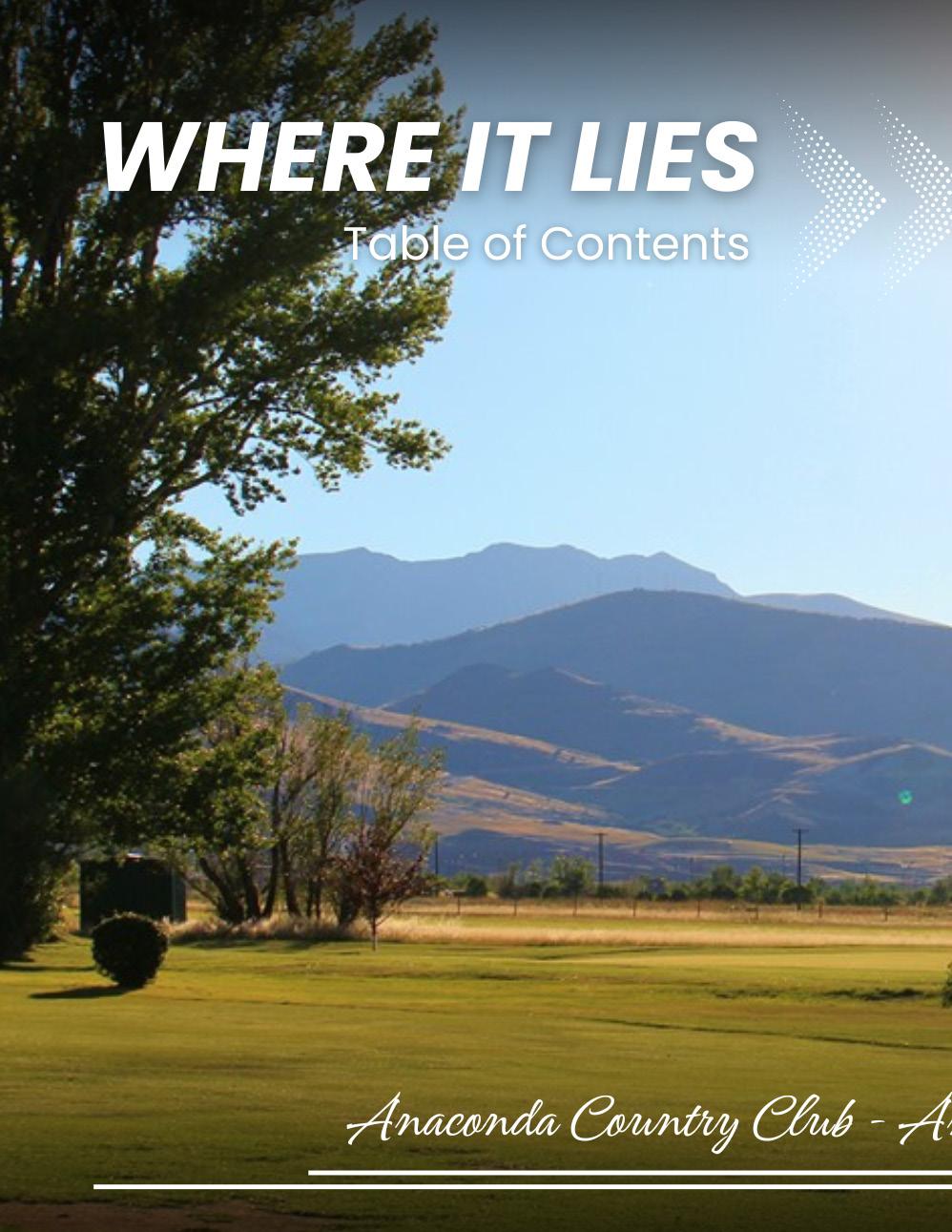
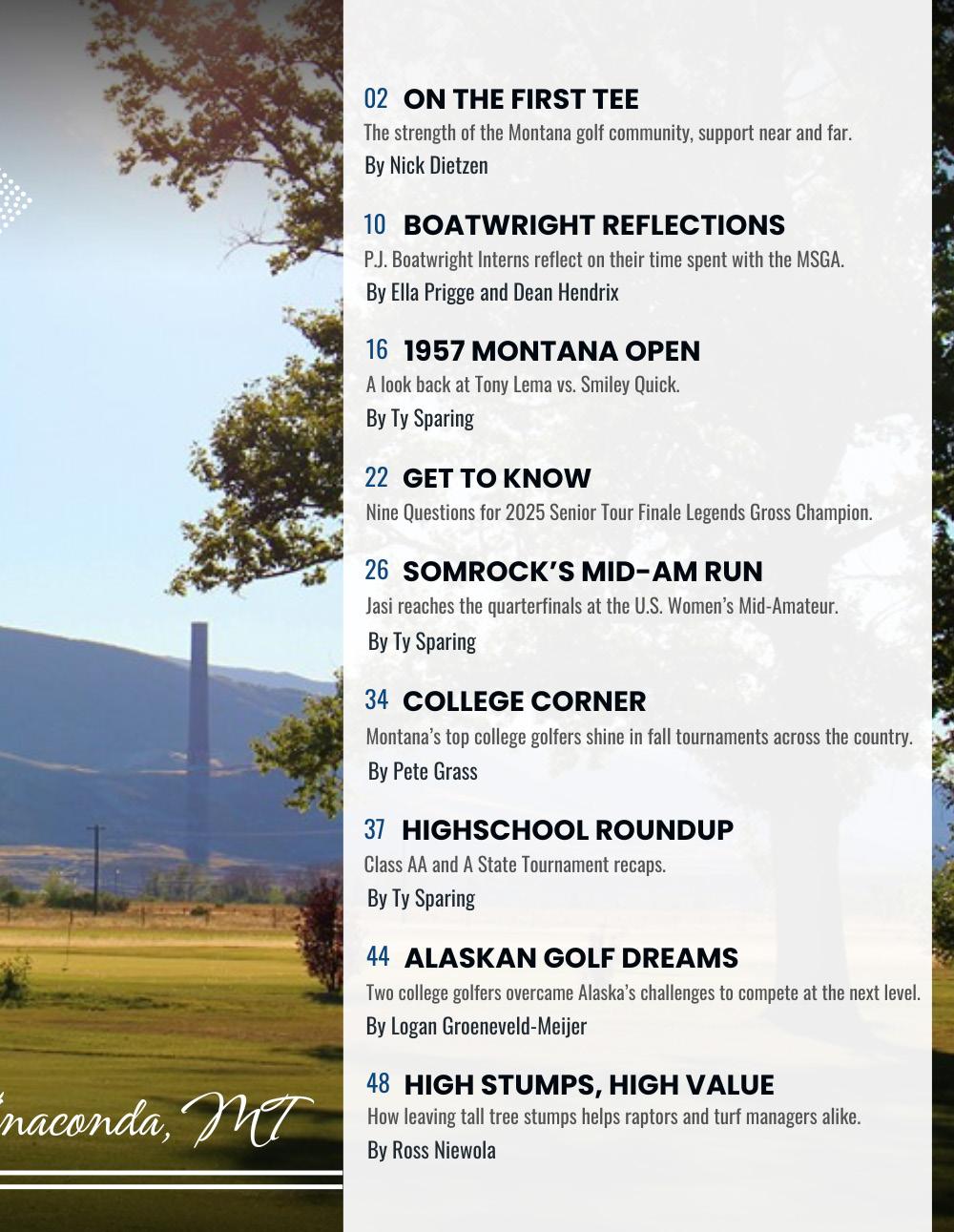

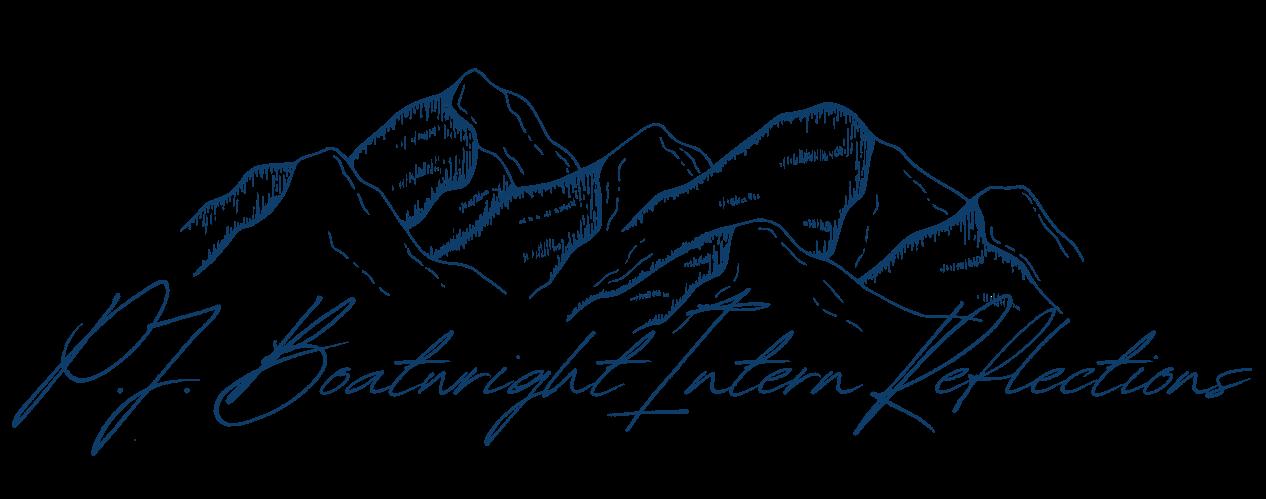
BY ELLA PRIGGE MSGA P.J. BOATWRIGHT INTERN
I’ll soon be wrapping up my term as a P.J. Boatwright Jr. Intern with the MSGA and beginning a new journey in Washington D.C. as a Public Affairs AmeriCorps Fellow for the National Park Service. It’s an exciting next step that will allow me to combine my interests in public service, environmental stewardship, and community engagement. As I make this transition, I’m especially grateful for the skills and experiences I’ve gained during my time as a Boatwright Intern. From supporting tournament operations, to learning about content development for 406GOLF, to strengthening my communication and organizational abilities, each part of this role has prepared me for what comes next.
But more than that, this summer gave me a chance to reconnect with the game that landed me here. Over the past few weeks, I’ve found myself reflecting not just on this internship, but on my relationship with golf as a whole.
I started playing as a child with my family and fell in love with the game early on. Through the Southwest Montana Junior Golf Tour, I met so many incredible friends, and golf became a constant in my life. By the time I played four years with Butte High and worked several summers at the Butte Country Club, it felt like golf had shaped a big part of my identity. I even went through some of the college recruiting process, but ultimately decided against playing collegiately.
Even after I stepped away from pursuing collegiate golf, the game didn’t stop weighing on me. For years, golf became a source of anxiety instead of joy. While this probably sounds dramatic, I saw every round as a reflection of who I was, which made it embarrassing, frustrating, and not fun. One moment that sticks with me is from May 2023 in Butte. “Winter rules” were in effect as the course was still thawing and the grass was growing in, and I hadn’t touched a club in months. Still, I refused to take a drop, played terribly, and stormed home after shooting what was probably a good 48 on nine holes. My brother just laughed, telling my parents, “She hasn’t played in forever and is acting like she’s on the PGA Tour.” That exaggeration hit close to home— golf always felt impossibly serious to me—if I wasn’t playing like a 4-handicap instantly, then I was failing.
The farther I drifted from competitive golf, the lighter I felt. But stepping back also meant losing connection with the friends I’d grown up playing with. They were still traveling and competing, while I chose to remove myself.
This summer completely altered this perspective. I re-entered the tournament world, but from the other side, and it took almost nothing for me to fall in love with the game again. Suddenly, golf wasn’t a topped shot or holding back tears walking down a fairway (well, so long as you don’t bring up hole 11 at Buffalo Hill during State Four Ball). Golf was watching old friends reconnect at the Mid-Am and introduce each other to their kids. It was
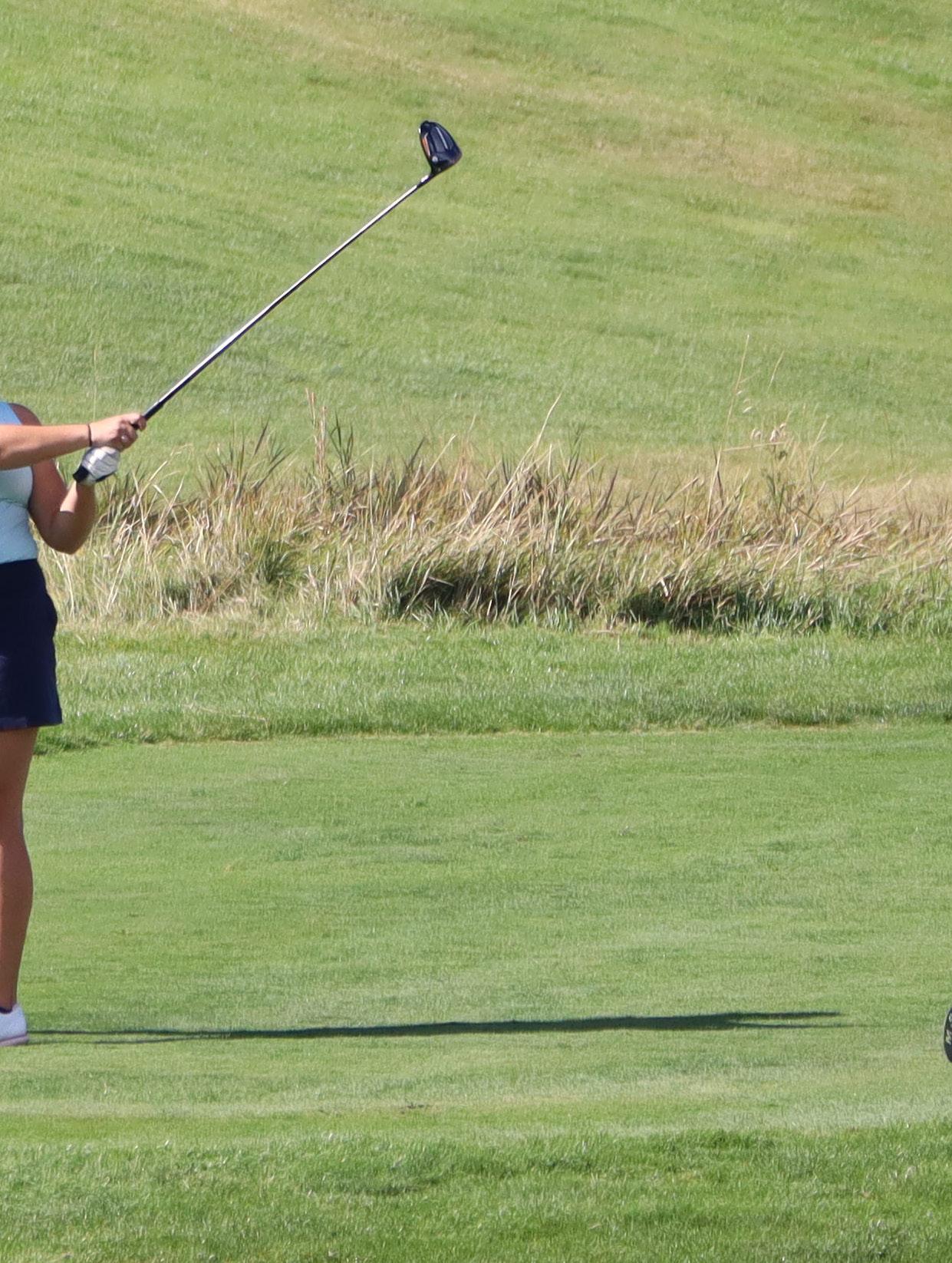
learning about the game’s storied history from Ty and Shanda. It was laughing with Dean and Ian while we tried to tape together the Match Play scoreboard. It was casual rounds at beautiful courses and a transfusion or two with Nick, Tim, Katie, and Jess after a long day. It was watching 14-year-old girls—who reminded me so much of my younger self—standing nervously over a tee shot at State Juniors, and feeling for them in a whole new way.
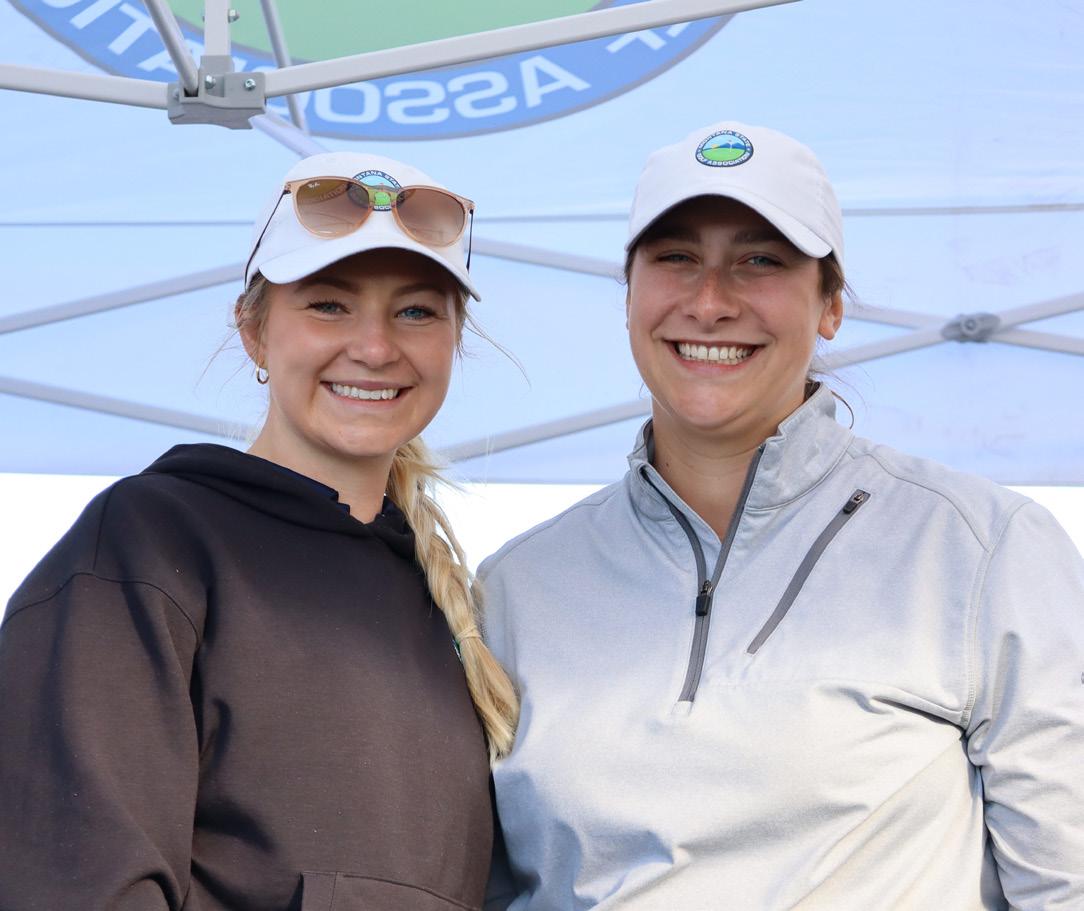
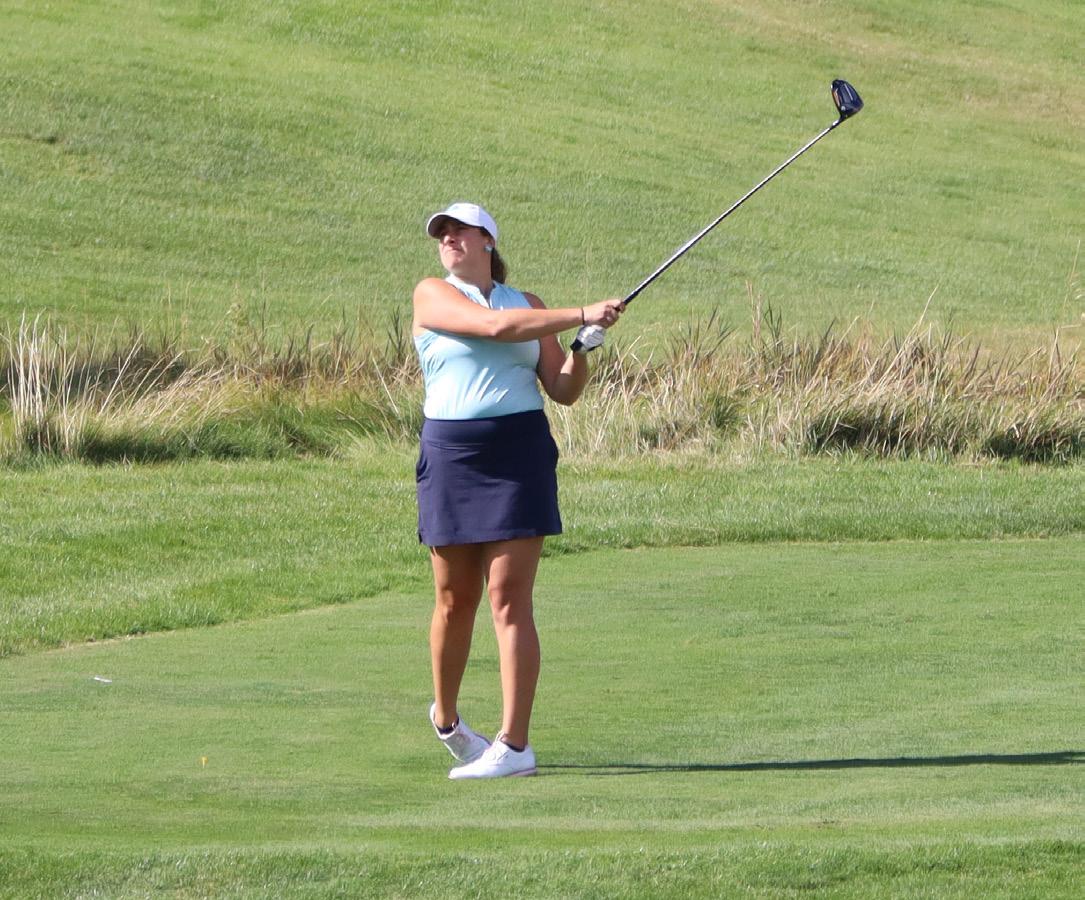
If you told me four years ago that I’d be sitting at the Women’s State Am wishing I could tee it up, I would have laughed. But here I am, and that’s because of this incredible Montana golf community that reminded me to love the game for what it is, not the number on my scorecard. I’m a little embarrassed it took me this long to get here, but I’m so grateful I finally did.
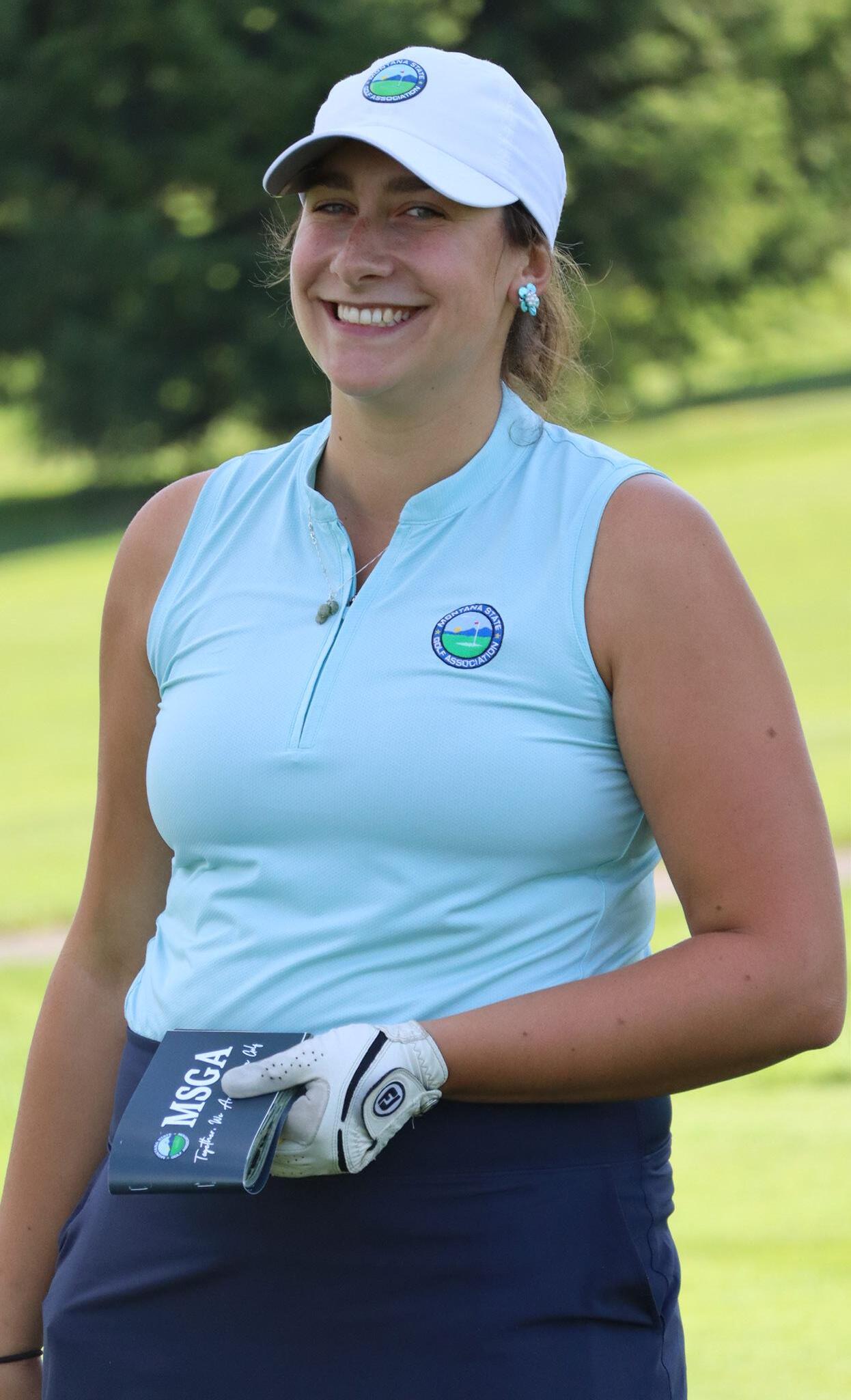
BY DEAN HENDRIX
MSGA P.J. BOATWRIGHT INTERN
The USGA PJ Boatwright Internship is a prestigious program designed to immerse aspiring professionals into the world of golf administration. Named after P.J. Boatwright Jr., a legendary figure in the USGA, this internship offers hands-on experience in managing tournaments, supporting junior golf initiatives, and promoting the values of the game. Below are several insights gathered from participation in this program.
Interns gain a comprehensive understanding of golf operations, including tournament
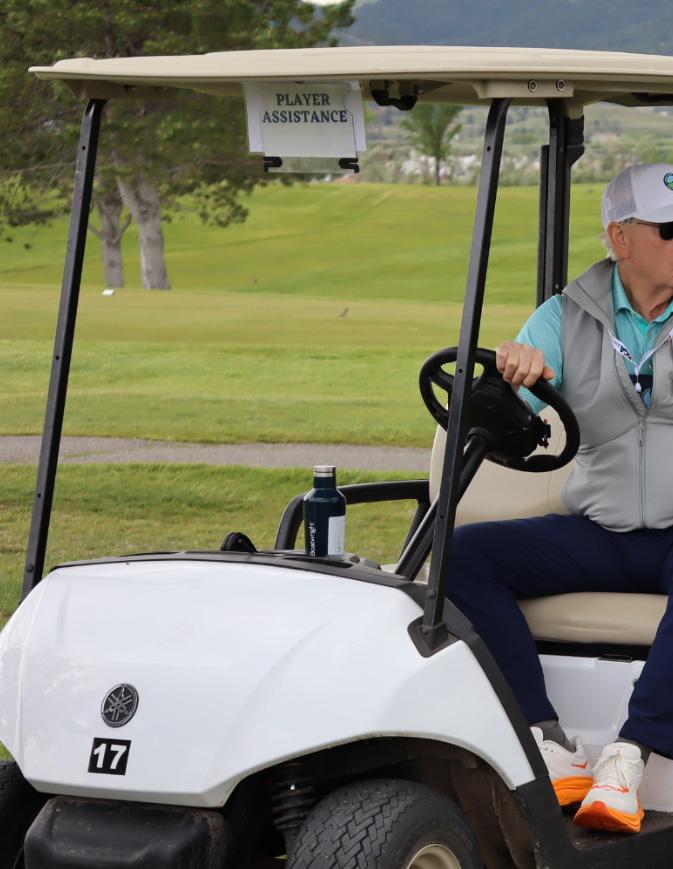
management, course rating, rules education, and event planning. This experience builds organizational skills and offers insight into the daily operations of golf associations.
Setting up and running a tournament can be an intense and fast-paced experience, as well as long days. This was the most fun I have had working for a long time. The activity reminded me of a Confucius saying, “out of chaos comes order.” We normally arrive at a course by 7am, then for about 2 hours, there is no stop. At the end of the day, once the course is clear, the breakdown starts. This entails taking everything down, storage locally, if the courses provide storage or placing all items back in the truck. If tournaments are multi-day, we must do the pairings, print the scorecards, cart signs, tees sheets, rules, and hole positions. These tasks, which may take
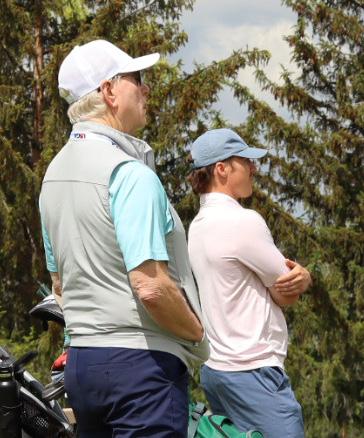


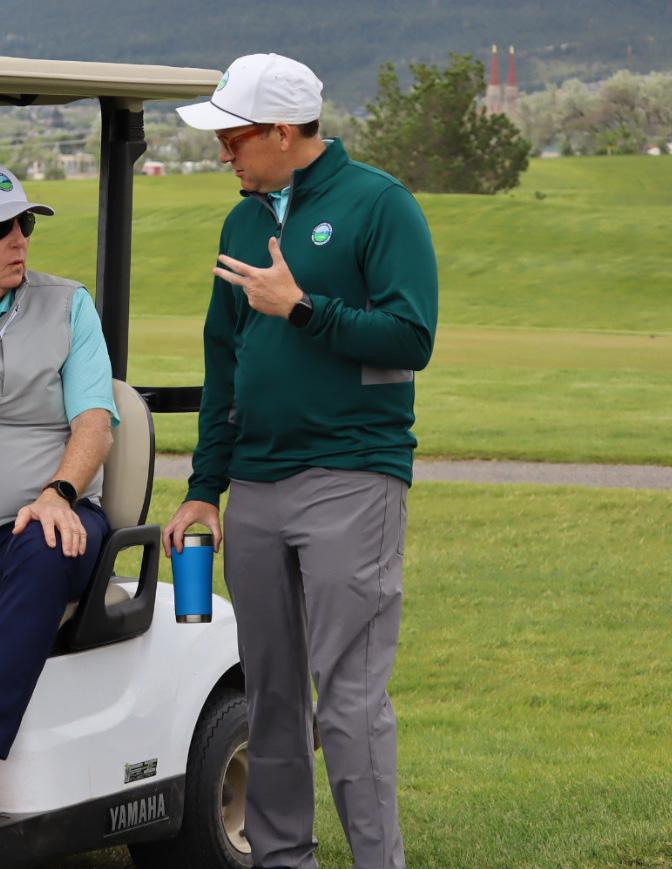
4-5 hours in the office, are completed onsite in only a few hours. It takes organization and teamwork to be ready for each day’s events. Kudos to the MSGA team, now I know what a good tournament looks like and organized.
Favorite Tournament: State Juniors. These youth are splendid examples of how we should all be playing the game, in terms of sportsmanship. They inspired me and have changed my approach while playing with other players. I will rake your bunker anytime.
Boatwright interns interact with a wide range of players and professionals within the golf industry. These interactions may help build a valuable network and foster relationships that can lead to future career opportunities. This experience was a close second. The PJ Boatwright Intern Summit in Liberty Corner, NJ was incredible. The talk given by Mike Whan, (whoa!), was excellent, the USGA Museum, being in Arnie’s Room, seeing Ben Hogan’s memorabilia, meeting over one hundred other interns, making a TikTok video with Maddy Montoya, these experiences were just cool. The saying about a kid in a candy store applies here. Meeting players from all over the great state of Montana, whether their HCP was plus 4 or 30, we have many super nice people playing golf in Montana. Thank you!!
Learning and understanding the rules of golf is a sizable portion of the internship. Interns attend seminars, officiate at tournaments, and assist with rules enforcement, deepening their appreciation for the integrity and sportsmanship that underpin the game of golf. I have learned that knowing the rules can save you strokes. On several occasions this summer I saved strokes by knowing more of the rules. Rules Official is one area I plan on
pursuing further.
Big thanks to Shanda Imlay for her help and patience answering my never-ending string of questions and whys.
The internship is a transformative experience, offering personal growth through challenges and successes. Interns reflect on their career aspirations, gain confidence in their abilities, and emerge with a clearer sense of direction within the golf industry or beyond.
Saved this one for last, (but not least). I started seriously playing golf about 7 years ago. Specific areas, taking lessons, competitions, trying to understand the courses I played, the setup of a course and how to manage my game and shots played. I love the challenge of a course and trying to overcome the last shot to make the next shot a good shot. If you met me this year, you know I am outgoing and gregarious. I learned that this gregarious trait does not always carry over to the golf course well. Tim Bakker told me on several occasions, slow down and manage your excitement, thank you Tim. In representing the MSGA, my actions can reflect on the rest of our team. This MSGA team is a winner and good people. I want to be a positive influence and make contributions that help this team, not become a hindrance. At the youthful age of sixty-eight, I learned many valuable lessons this year.
Participation in the USGA PJ Boatwright Internship has provided me an invaluable experience in golf administration and event management. I am grateful for the opportunities to broaden my professional network, enhance my appreciation for golf, and grow both personally and professionally.
Working alongside Nick, Tim, Katie, Shanda, Ella, Stella, Emily, Ian, Ty, and Beth has brought new joy and purpose to my life. Thank you to the entire MSGA team for making this journey so rewarding.


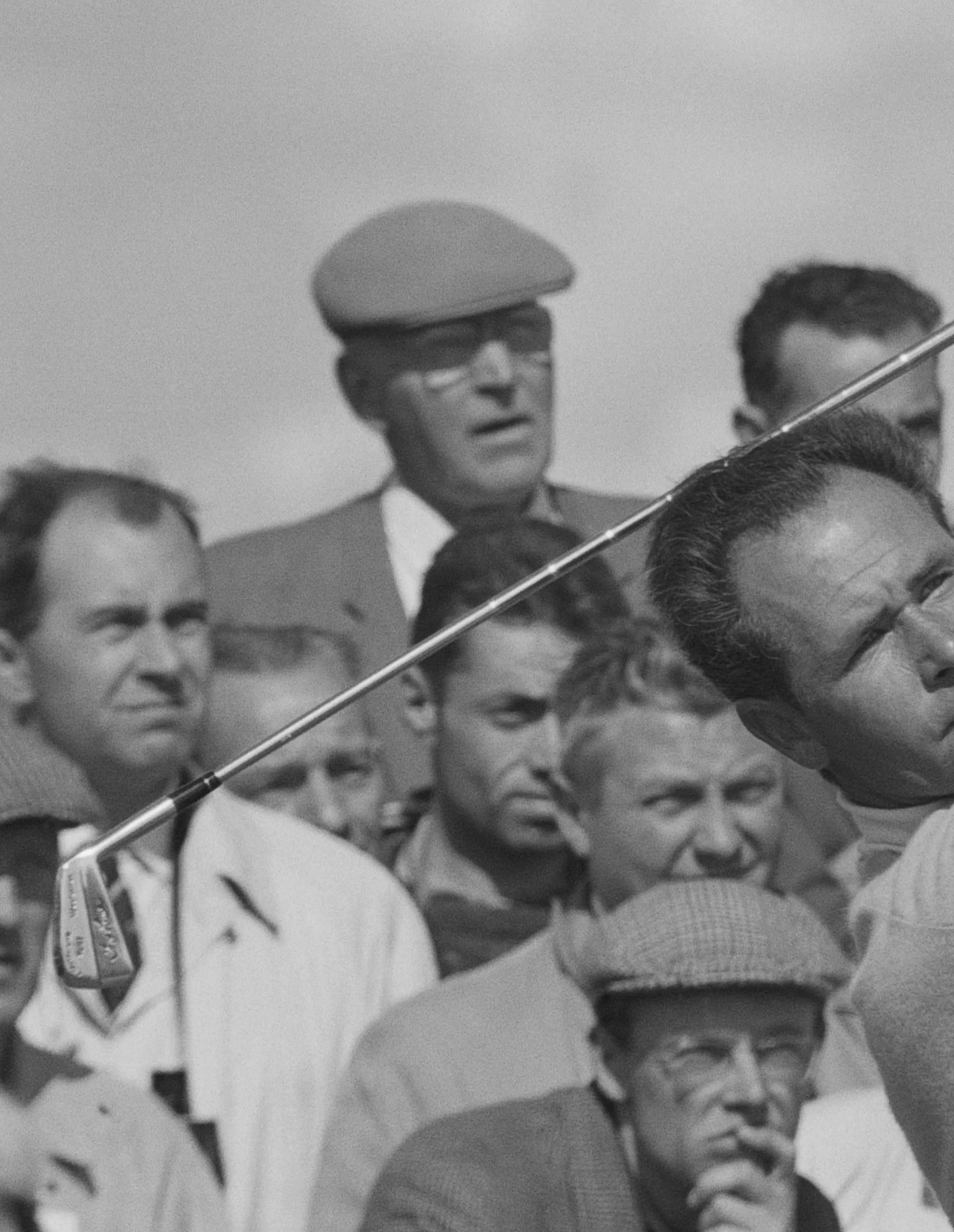
BY TY SPARING MSGA COMMUNICATIONS COORDINATOR
If you’re a golf fan of a certain age, or a historian of the game, you might recognize the name Tony Lema. In the early 1960s Tony Lema was a burgeoning star on the PGA Tour, having accumulated a series of victories including the 1964 Open Championship at St. Andrews. He won by five strokes over a young Jack Nicklaus.
Nicknamed “Champagne Tony” because he would hand out bottles of champagne to the press every time he won a tournament, Lema was known for his sense of humor and general zest for life and was one of the more popular golfers on the pro tour. But in 1957, when it was still early in his professional career, the 23-year-old was still hustling his way throughout the country trying to make a name for himself when he made a stop at the Hilands Golf Club in Billings for a chance to play in the 1957 Montana Open.
It was a strong field that year too, Hilands pro Paul Allen even remarked at the time, “all in all, as it stands now, it’s the finest golfing field ever assembled in a Montana tournament.”
One of North Dakota’s best all-time golfers, Paul O’Leary, was in attendance along with Montana State Amateur champions Ed Zemljak, Russ Swanson, and George Sarsfield. The 1954 Montana Open winner and
eventual PGA Hall of Famer, George Schneiter was also there. Along with being a great player, Schneiter had a distinguished career working as a manager in the PGA Tournament Bureau (a precursor to the PGA Tour) and designed the Lake Hills Golf Course in Billings.
Not to be forgotten were wily old professionals like Smiley Quick, Abe Espinosa, and Willie Goggin — guys who had tournament wins dating back to the 1920s.
The southern California pro Smiley Quick (pronounced quake) in particular stands out as the most inscrutable character that showed up to the Montana Open that week. A guy who was “built like a jeep” and had “forarms like Popeye,” Smiley was a great golfer at times in his life. The year before he went pro Smiley won the U.S. Public Links Championship in 1946, and the same year was U.S. Amateur runner-up and a member of the Walker Cup team. Talented golfer yes, but he had a way of sticking out like a sore thumb as one writer from the era put it, Quick represented “the other side of the railroad tracks…He’s about as Country Club as Tony Galento” (*Galento was a boxer known for his crude, unsportsmanlike style of fighting).
More than golf, Quick was well-known for his abrasive personality and gambling exploits on the course. He was like a weird combination of Happy Gilmore and Evel Knievel.
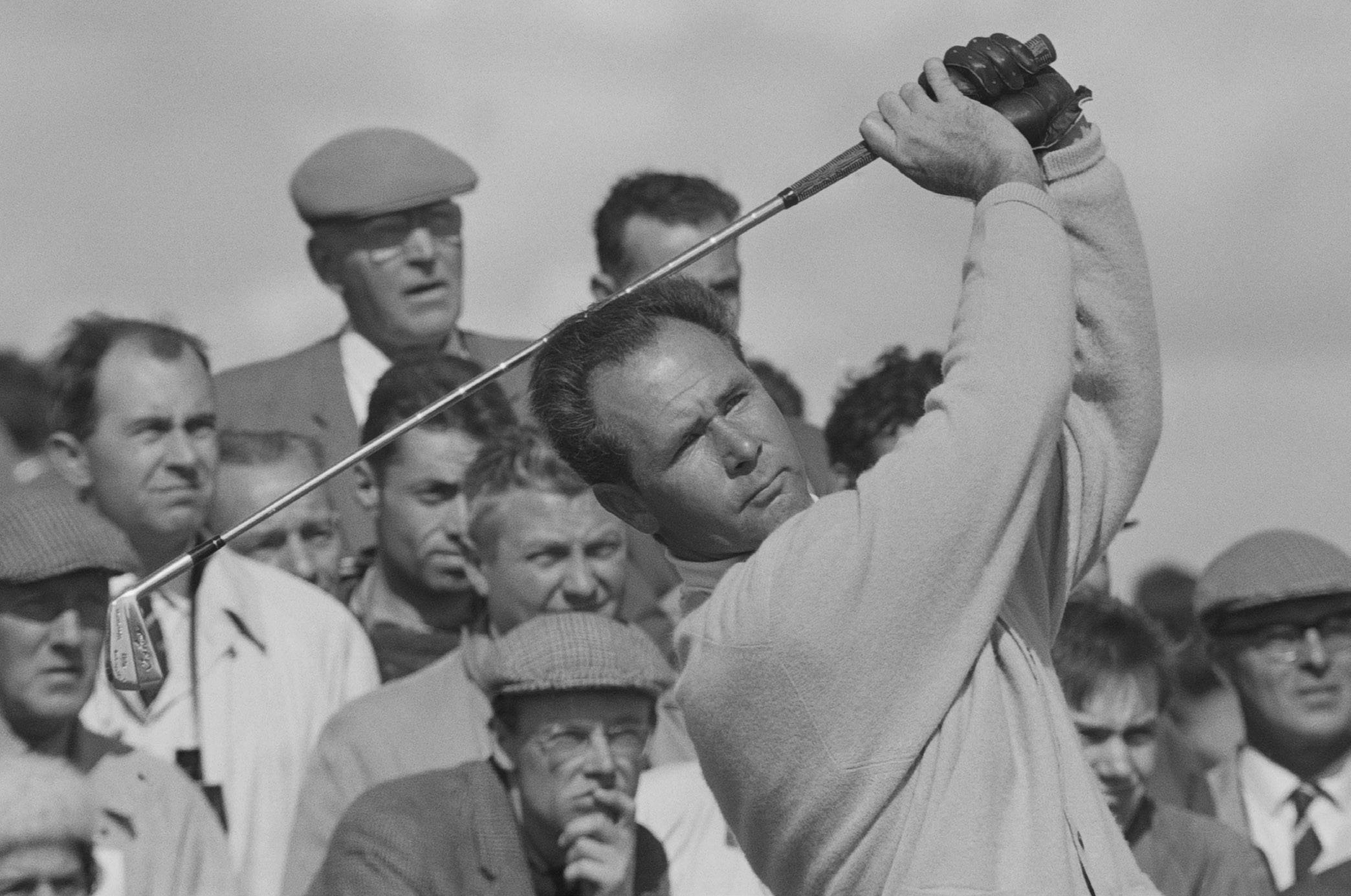
A one-time sidekick to the famous golfing hustler, Titanic Thompson, Quick famously bought himself an apartment and several cars after he “got rich de-millionizing a boxer who thought he could beat him in golf.” That boxer was Joe Louis.
There are many outrageous stories of Smiley Quick, who as a young man legally changed his first name from Lyman to Smiley. He once built a five-hole course on the island of Tarawa while stationed in the south Pacific during World War 2 and started a gambling golf ring. As one 1946 article described it, the soldiers “on the island had dough and no place to spend it.” Always the conniver, “Smiley Quick decided the best way to get the gobs poetically interested in the finer things of golf was to play with him for $100 a hole. His Philosophy: ‘You can’t start a sucker out too soon.’”
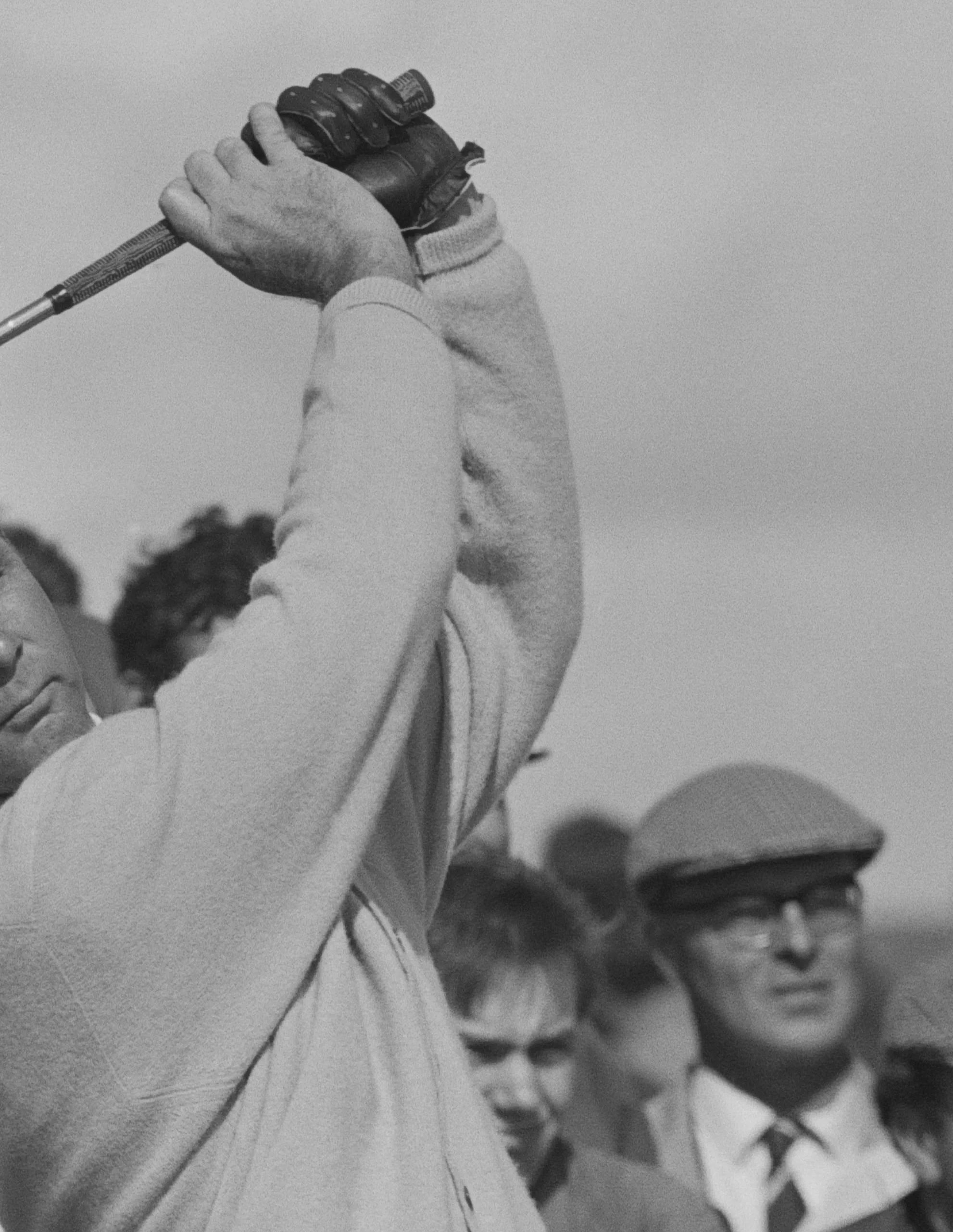
The “stormy petrel of Southland golf” Smiley Quick was seemingly disliked and mistrusted everywhere he went. One Deseret News article from a month before the Montana Open in 1957 claimed that “Quick has given the Utah Open a rancid sort of odor for quite a few seasons now.” Utah golf administrators were already sick of his “perennial misbehavior,” but Quick had gone over the line the previous year when he stormed off the course in the middle of the tournament and threw his three iron and ball on top of the caddy house on his way out.
When asked about the incident a year later, the always irascible “Un-Smiley” said “Ain’t no sense enlargin’ my ulcer—I can’t get the ball in the cup on those so-and-so greens so I put the ball in my pocket.” Utah Open administrators considered banning him from the event in 1957 but deferred and instead
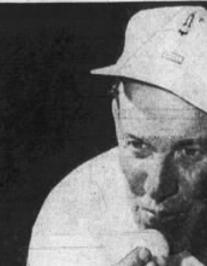
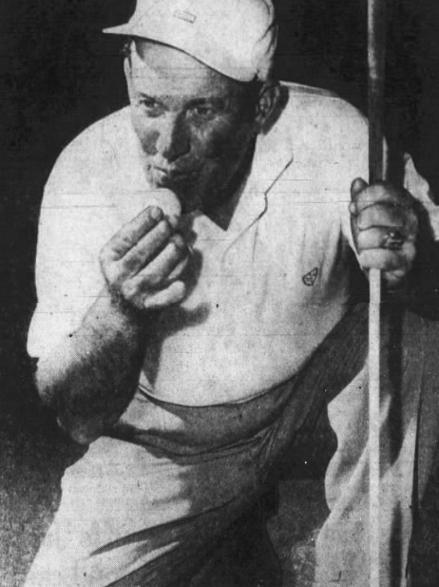
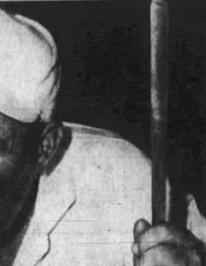
made him pay a “$200 good conduct bond” in order to register, much to the consternation of fellow players. The fans, however, loved watching the Smiley Quick show, and he always drew large galleries.
Tony Lema meanwhile had recently made a name for himself with his first professional win at the Imperial Valley Open and was on the shortlist with Quick as true contenders at the Montana Open. In fact Lema’s star was on the rise and only a year later he would have a successful first season on the PGA Tour with earnings over $10,000 ($114k in today’s terms).
It was under these settings that the Montana Open coalesced at the Hilands Golf Club in August of 1957.
Once on the scene Smiley was quick to administer his patented “long psychological needle” on the competition, starting when he gave a condescending assessment of Lema’s game to a local reporter before the Open began. “Lema has a lot of power,” Quick said, “but it may take him a full year to find himself.”
The two golfers couldn’t be more different from each other. Lema was young, witty, likeable and seemingly the prototype of the new sort of PGA tour “celebrity” golfers that broke onto the scene in the 1960s. Quick on the other hand was near his peak as a player, yet to reach his prime as a hustler, and was loathed by golf administrators all over the western United States. Yet for all of their differences, Smiley Quick and Tony Lema seemed to agree at least on one thing—they loved the Hilands Golf Club.
After the event Lema was highly complementary of the historic Billings course, calling it “the greatest I’ve ever played.” Quick meanwhile, a man who had traveled widely in his golf pursuits, added “I have never found better fairways anywhere than those on the Hilands course.”
The Montana Open was a 72-hole event and with only nine holes left Smiley Quick had beguiled his way into a one stroke lead over New Jersey pro Willie Goggin, a man who was two years away from winning the PGA Senior Championship. Before teeing off on the back nine they were informed that Lema was three strokes back, and with a quick nod to Goggins, Smiley replied, “We aren’t worried about him.”
Lema, who thought he “was dead” after bogeying the seventh hole was indeed not dead and was relieved to learn on the very last hole that he actually had a chance to win the event. The three-stroke lead had been erased without Lema even knowing about it, and after parring to finish up the day at -6 (66) and -12 (272) overall, Smiley three putted for a bogey, giving Lema the win by one stroke.
Not to be too discouraged Smiley Quick took home $450 of the total $3,700 purse and came back in 1958 to win the whole event. Euphoric over another early win in his career and $750 in his pocket, Lema promised he’d be back to Hilands for the next Montana Open, but considering the trajectory he was on, that would never happen.
“Champagne Tony” became a reality in 1962 when Lema finally achieved his first PGA Tour victory at the Orange County Open Invitational. Despite a promising rookie campaign in 1958, he struggled to find his footing, and after coming close but no cigar a couple times in those intervening years, Lema promised reporters that he’d serve them champagne if he ever collected a win. He amassed 12 more PGA Tour wins over his career, culminating in the Open Championship victory in 1964 at St. Andrews in Scotland. Everybody loved it when the champagne came out.
A couple years later and with a few more
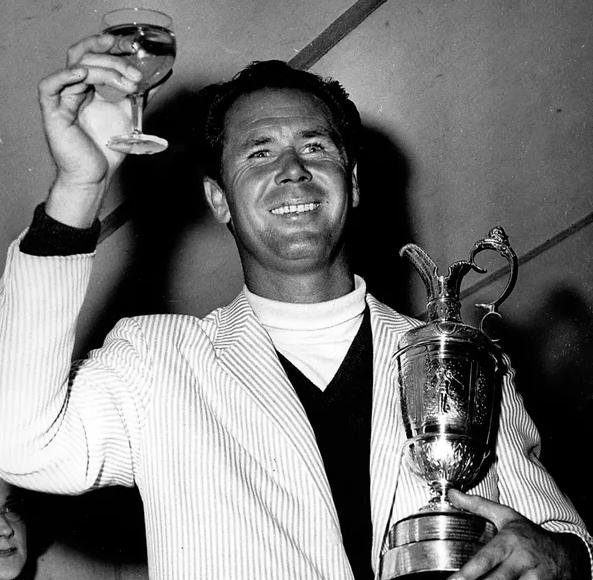
tour victories and top ten major finishes under his belt, at age 32 Tony Lema seemed destined for more but that was not the case. After finishing up the PGA Championship in Akron, Ohio, Lema and his wife boarded a small twin-engine Beechcraft airplane with intentions of getting to Chicago for a one-day pro-am event, but the plane ran out of fuel and crashed into the nine-hole Sportman’s Club Course in Lansing, Illinois,
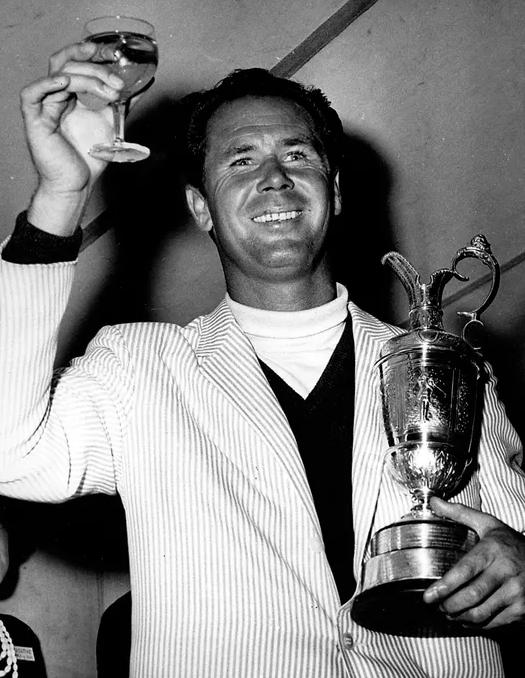
killing everyone on board. The headlines the next day read “Tony Lema Died Where He Lived—On a Golf Course.”
As for Smiley Quick, he kept golfing, gambling and causing trouble until 1979 when after playing a round at the Laguna Beach Golf Club, he returned home and died of a heart attack while watching TV. He was 70 years old.

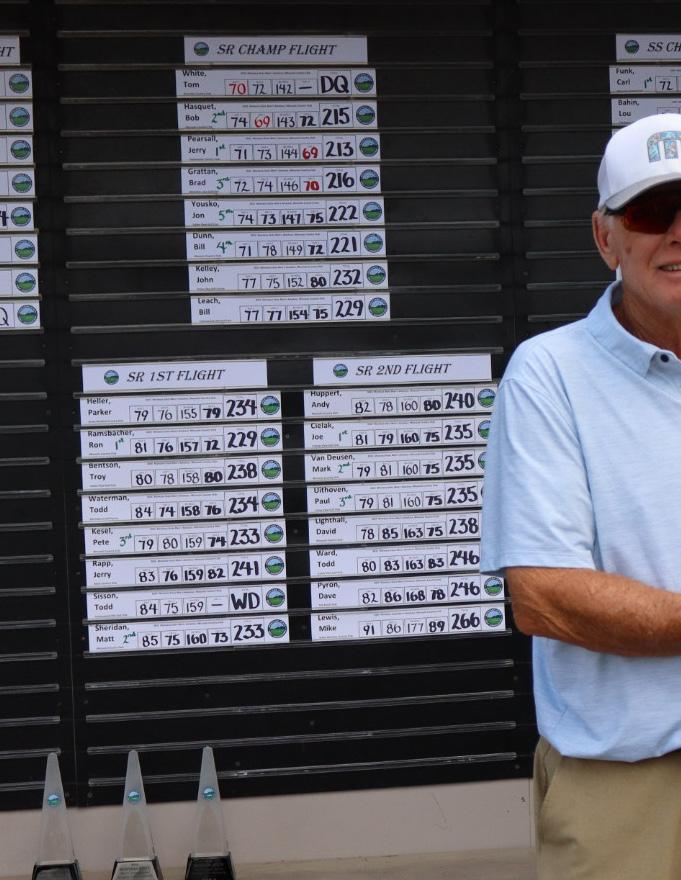
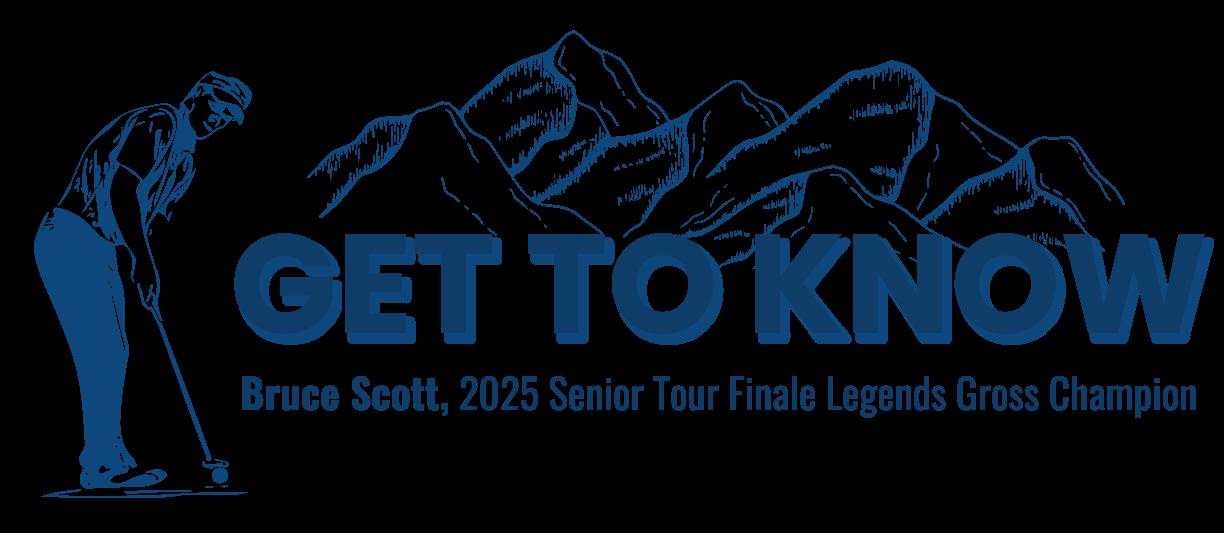
1. Who introduced you to golf?
I had always played golf once or twice a month but without any real goals, the main one was to out drive my buddies. I remember when I turned 50 I could no longer compete in tennis as my knees and elbows wouldn’t take the beating anymore. I missed the competition so I looked around and asked what did Phoenix have to offer and golf came right to mind. So I assembled a set of clubs and started out. It helped that you could practice by yourself and didn’t need someone to practice with. So I spent many hours at the range.
2. Who influenced you most in your golf life?
Jean-Claude Killy, the skier, and Bjorn Borg the tennis player. They taught me form is a means to an end but not the end itself.
3. How was the Senior Tour finale at Wilderness Club? You won the Legends Gross Title, how does it feel to end the season with a win?
The Wilderness Club was in great condition, the greens rolled true and the weather was perfect. The tourney went off perfectly, but in my experience most of them do. More importantly, the staff at Wilderness Club and MSGA were welcoming and gracious. Winning is great, especially when
you play well but has to be tempered with the fact all these guys you’re playing against have become your friends. Having said that, the drive home is a lot shorter when you win.
4. What is your favorite course in Montana and why?
Two courses. Laurel Golf Club and Missoula Country Club. Not only are the courses challenging requiring you to shape the ball, but the people, both the staff and members went out of their way to make you feel at home. Great experiences!
5. What is a dream golf course you’d like to play once?
It seems to me the best courses are the ones you play with your buddies. However, if we could get together at Cypress Point in the Bay Area…
6. What is your dream celebrity foursome (living or dead)? Why would you choose them?
I would have liked to play with Arnold Palmer. I would round out the foursome with people who have a zest for life, know how to compete, love to travel and love golf. As I get older, I find fewer people who fit these conditions.
7. What’s your most memorable moment on a golf course?
I recently played a senior tournament in Laurel. I was paired with three golfers that I’d played with before and knew them to be very good golfers. At hole number one the first nailed it right down the middle. The second guy shanked his drive directly into the woods on the right. Hit a provisional and it followed the first one into the woods. We didn’t find the first one but the second one was behind a tree stuck in the roots. He took a big number on that hole and unfortunately it didn’t get any better as the round progressed.
I watched him stand over each shot trying to make solid contact but it just didn’t happen. He never got angry, didn’t throw up his arms and give up and never interfered with any one else’s game. He was easily 15 shots above his average. I made a bet with myself that he would withdraw after that, but there he was the next day on the first tee with the first group. He took the club back and ripped that ball down the fairway like

yesterday never happened. He became my hero, and I try to be on the first tee to send him off.
8. If you could change one thing about the game of golf what would it be?
Hitting out of divots and late tee times in tournaments.
9. What advice would you give to beginner golfers?
Find people who enjoy life and hold on to them as tight as you can. People who encourage you and are not jealous of your successes.
Bonus: Lay up or go for it?
That’s the beauty of golf. Knowing when to lay up and when to go for it. Remember, there is not much worse of a feeling than laying up and then screwing up the shot.
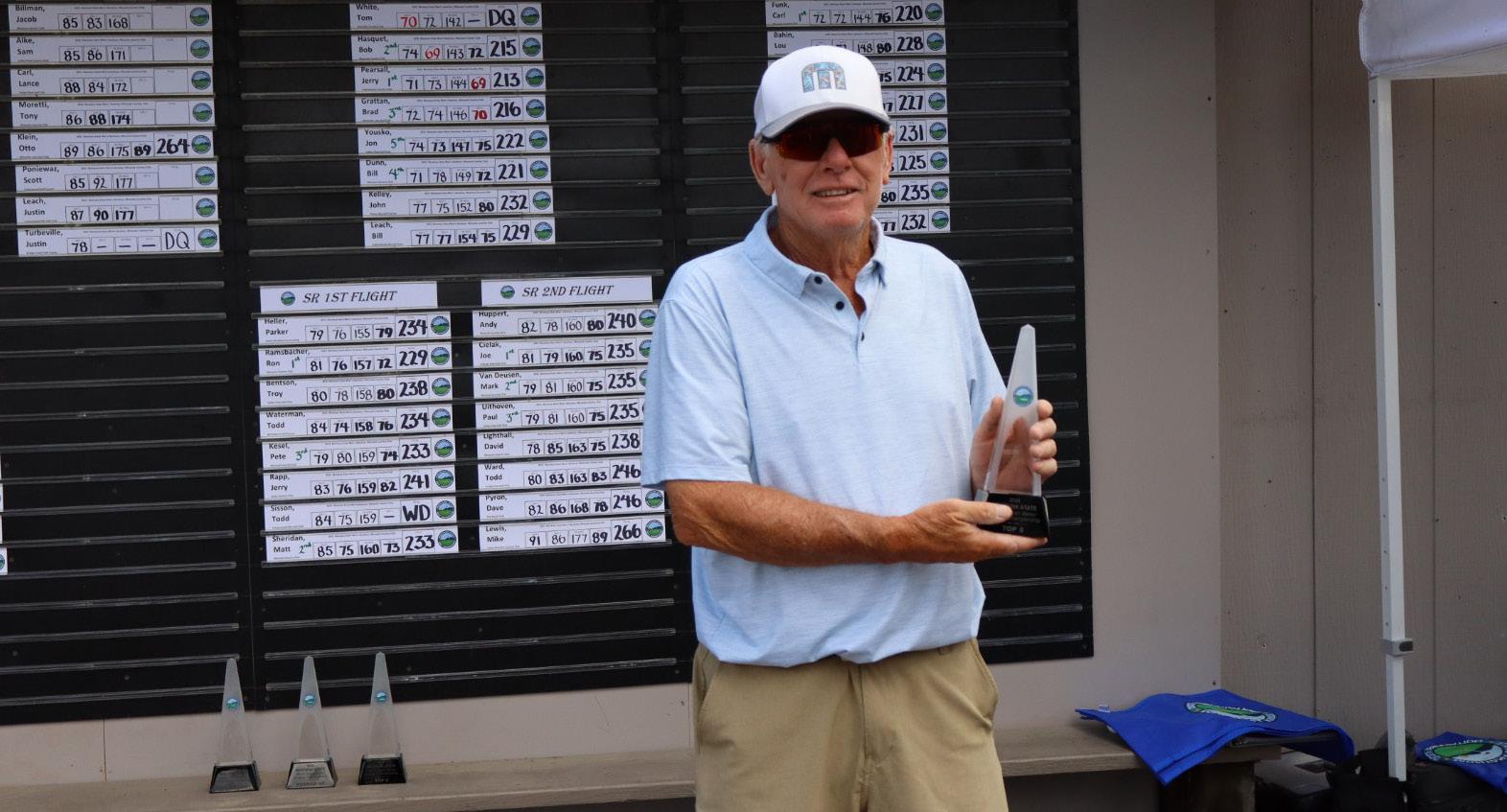


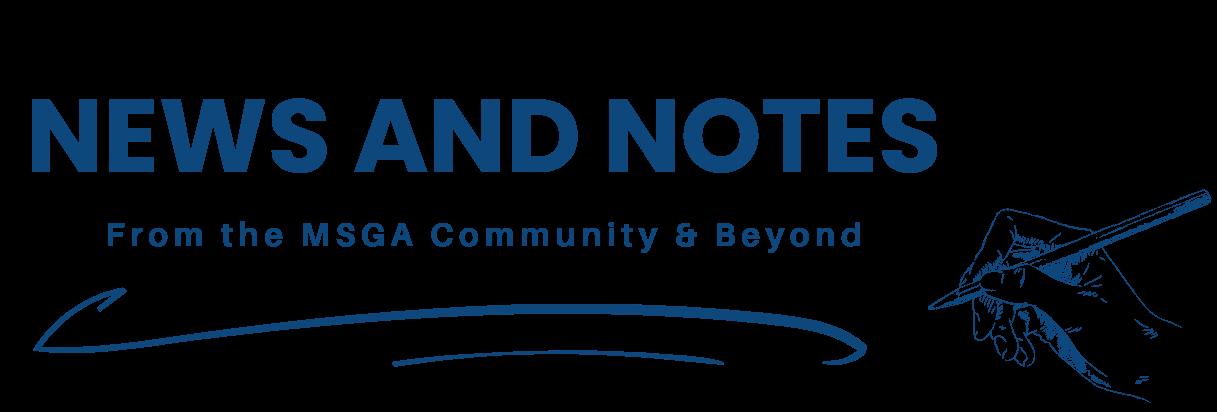
Jasi (Acharya) Somrock, a two-time Montana State Amateur champion made it all the way to the quarterfinals of the U.S. Women’s Mid-Amateur Championship recently at the Monterey Peninsula Country Club in Pebble Beach, California.
Somrock finished as a 23 seed after the
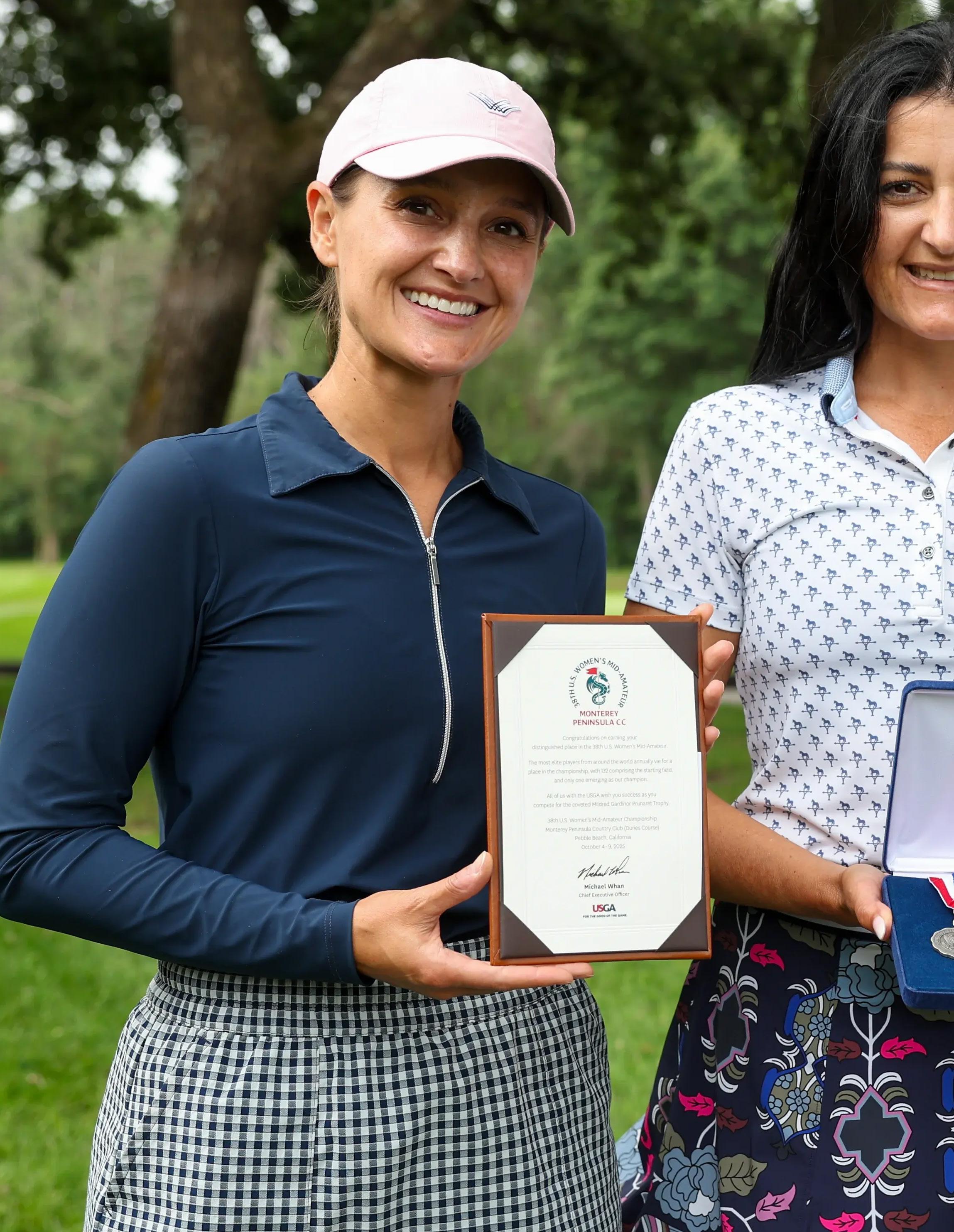
first round of stroke play qualifying and made it all the way through the match play rounds of 64, 32, and 16, before falling just short in the quarterfinals 1 up to Montgomery, Texas’ Shannon Fish-Martin.
It was the first USGA event for Somrock since qualifying for the U.S. Women’s Open at Pinehurst Resort and Country Club back in 2014.
A prodigious Montana talent, Somrock is no stranger to success on the golf course, having won four straight B-C individual golf titles for Columbus High School, won two Montana
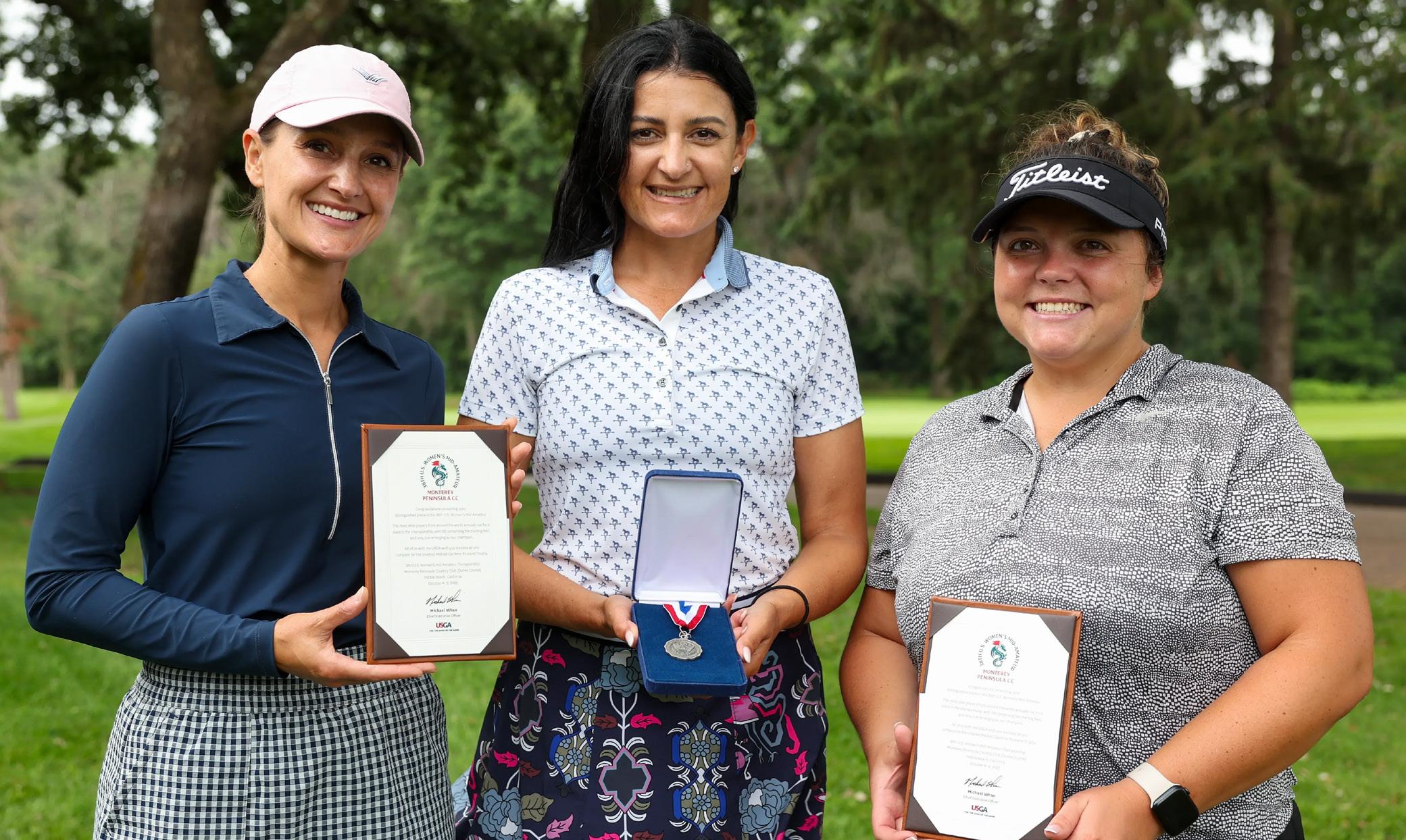
State Amateur titles (2004-2005) and a Big Sky Conference individual title while playing for the University of Montana (2003-2006), eventually moving to Minnesota where she won five straight Minnesota Mid-Amateur Championships.
For full results of the U.S. Women’s Mid-Amateur Championship, CLICK HERE
After running away with the individual title at the Diane Thomason Invitational in Iowa City to close out the month of September, Lauren Greeny was awarded the Big Sky Conference Golfer of the Week Award to usher in the month of October.
Greeny, a two-time Montana State Women’s Amateur Champion (2023-24), took first place by six strokes in a competitive field of sixteen teams, finishing with the only three-round score under par at -5 (211). She was propelled by a first round in which she broke the Finkbine Golf Course record after posting an absurdly low -8 (64) in which she carded nine birdies. Nobody came within six strokes of matching that score throughout the rest of the event, nor could anybody catch up to Greeny’s overall score as she won comfortably for the fourth time in her collegiate career.
Another great accomplishment for one of the best golfers in Montana State University program history!
Fresh off their respective state tournaments, ten top boys’ and girls’ golfers from
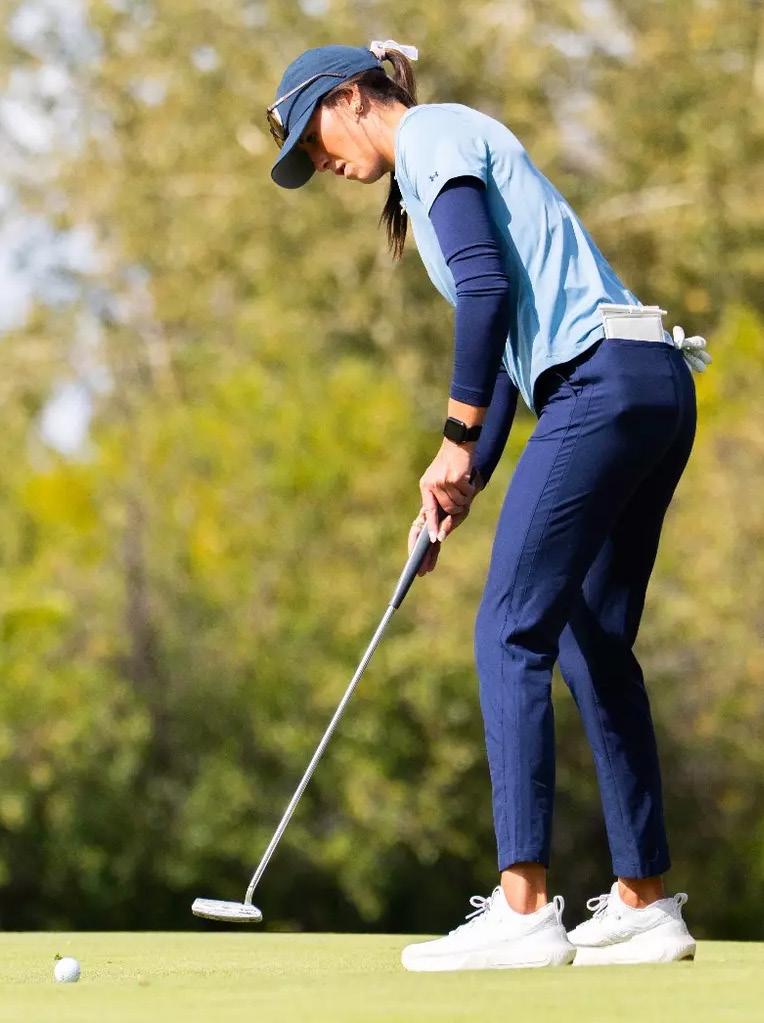
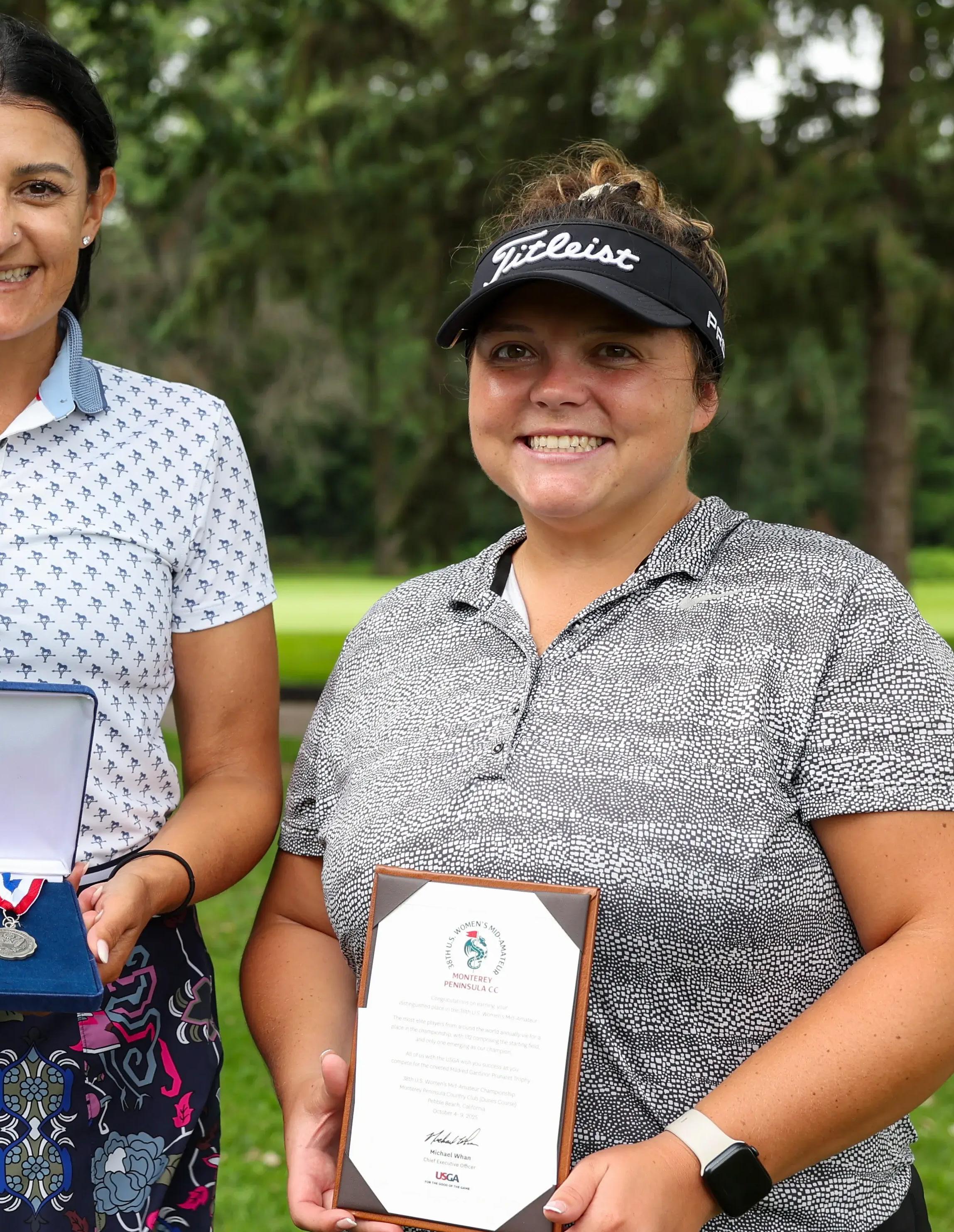
Class AA and Class A squared off in a match play event at the Rock Creek Cattle Company. Held October 6, the single round exhibition was a showcase of some of the fantastic youth talent found within the state.
On the girls side of things, the Class AA golfers won the event with seven wins and two ties. Of note, the state champs Payton Tryan (Billings Senior) and Anna Lende (Park High) played to a tie, while Hamilton’s Cameron Burnett was the sole Class A victor.
The Class A boys meanwhile narrowly took the win over Class AA with five individual wins and one tie. Capital High’s John Gilbert won the champions match over Billings Central’s Colin Jensen 5&4, and the only tie of the day went to Missoula Sentinel’s Willy Nowlen and Laurel’s Royce Taylor.
For full results, CLICK HERE
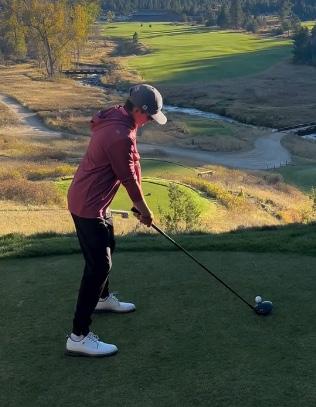
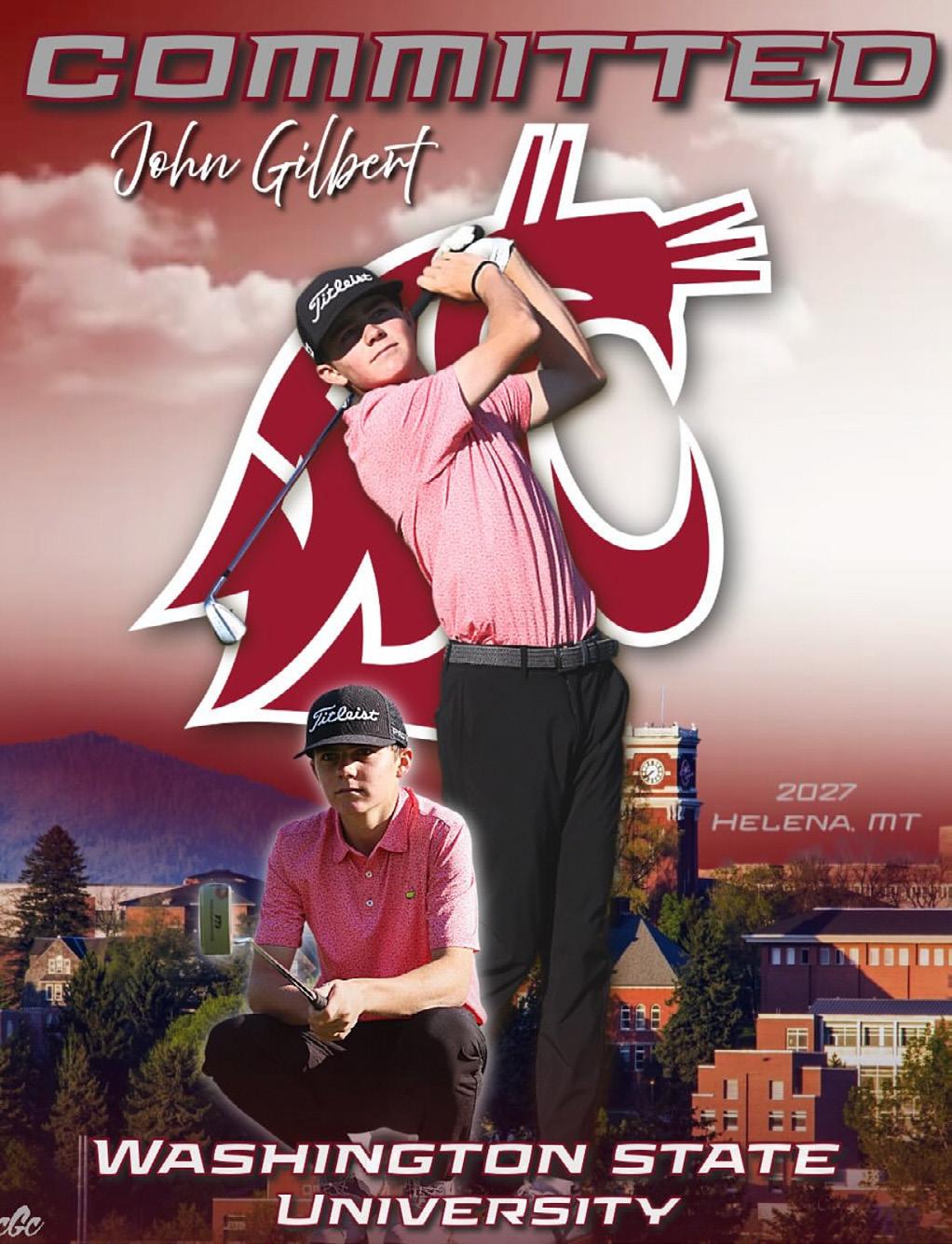
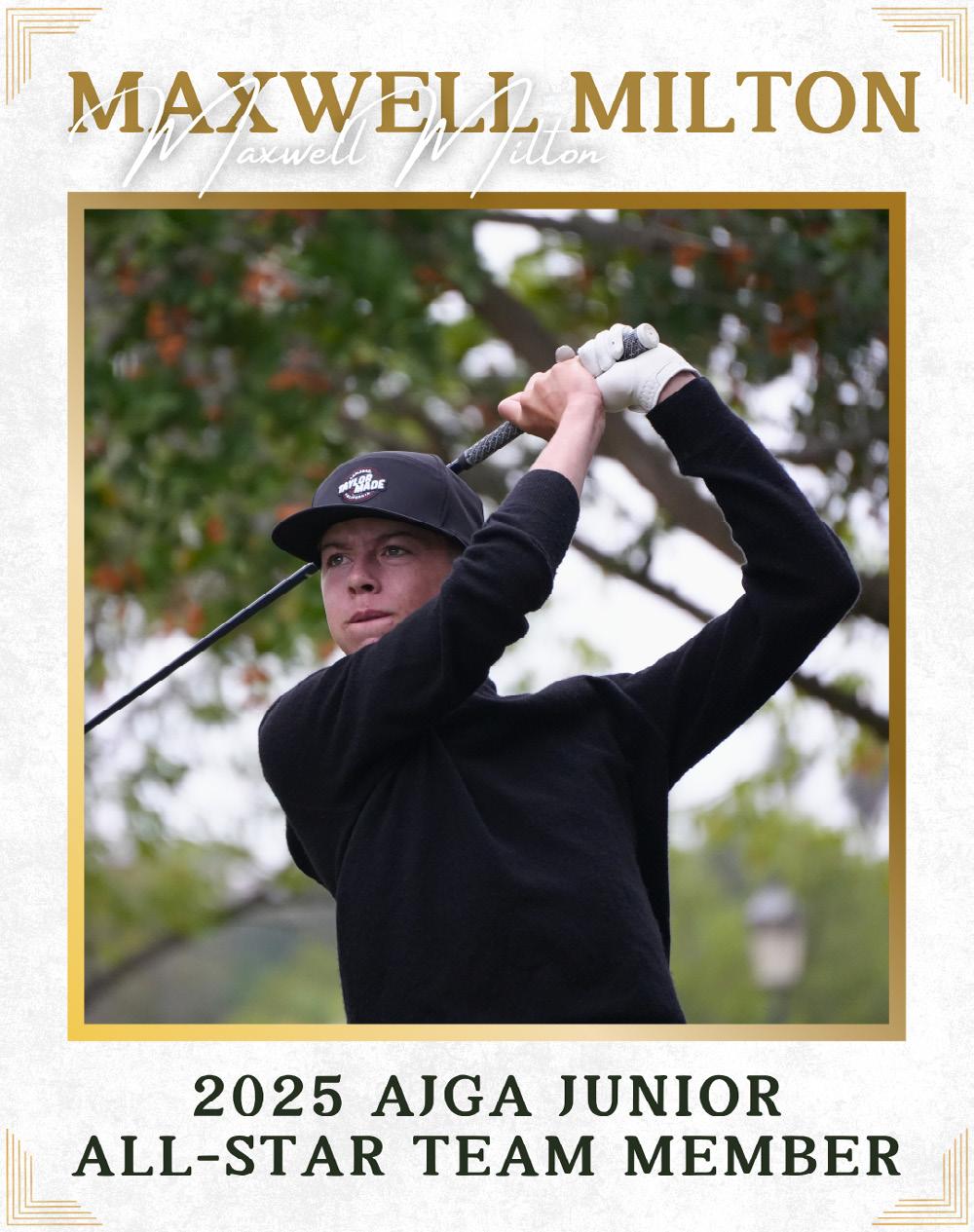
Capital High junior John Gilbert has recently announced his commitment to play golf for Washington State University. The recent Class AA high school champion has been one of the top youth golfers in the state for several years now, having recently finished runner up at the Montana State Junior Championships this past June, as well as his title run for the Bruins in early October.
We’re excited to watch John for one more year with the Bruins and will look forward to following his collegiate career unfold in Pullman, Washington. Congratulations John!
The American Junior Golf Association has recently announced its 24th annual all-star team in which it recognizes 10 qualifying golfers between the ages of 12-15. Determinations for the AJGA Junior All-Star Team are made based on the players Rolex AJGA Rankings. Players than received an invitation to play in the final event of the Ninja Junior All-Star Series at Le Triomphe Golf and Country Club in Broussard, Louisiana later this year.
Milton has certainly had a tremendous year on the golf course, winning the Class A High School championship as a freshman in 2024, followed by three top-10 AJGA finishes in 2025, including his title winning performance at the 2025 Visit Pullman Junior Championship. For those following his high school career, they know that Milton has put up some eye-popping scores and has established himself as one of the top young golfers in the state. Congratulations to Max on honors well deserved!
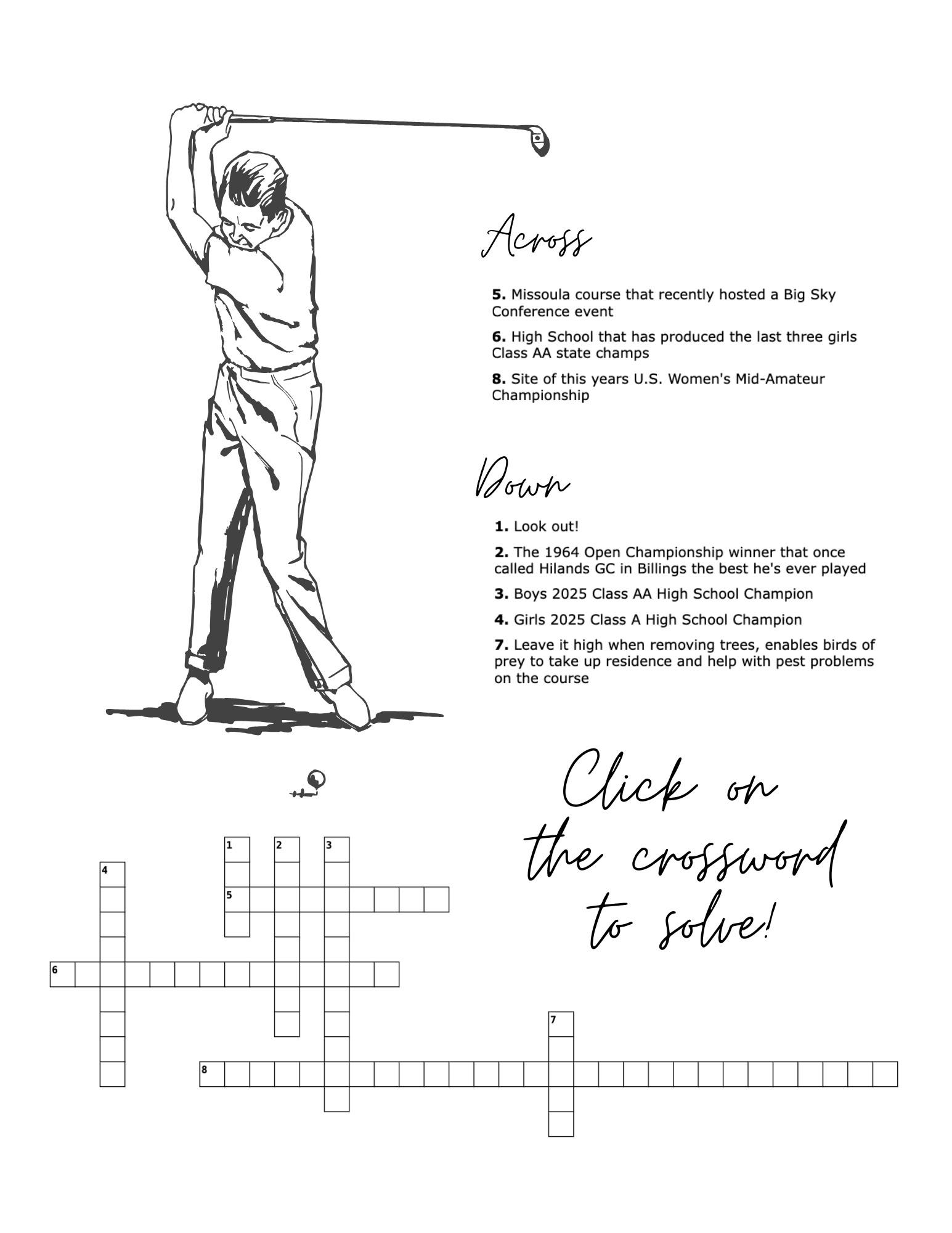

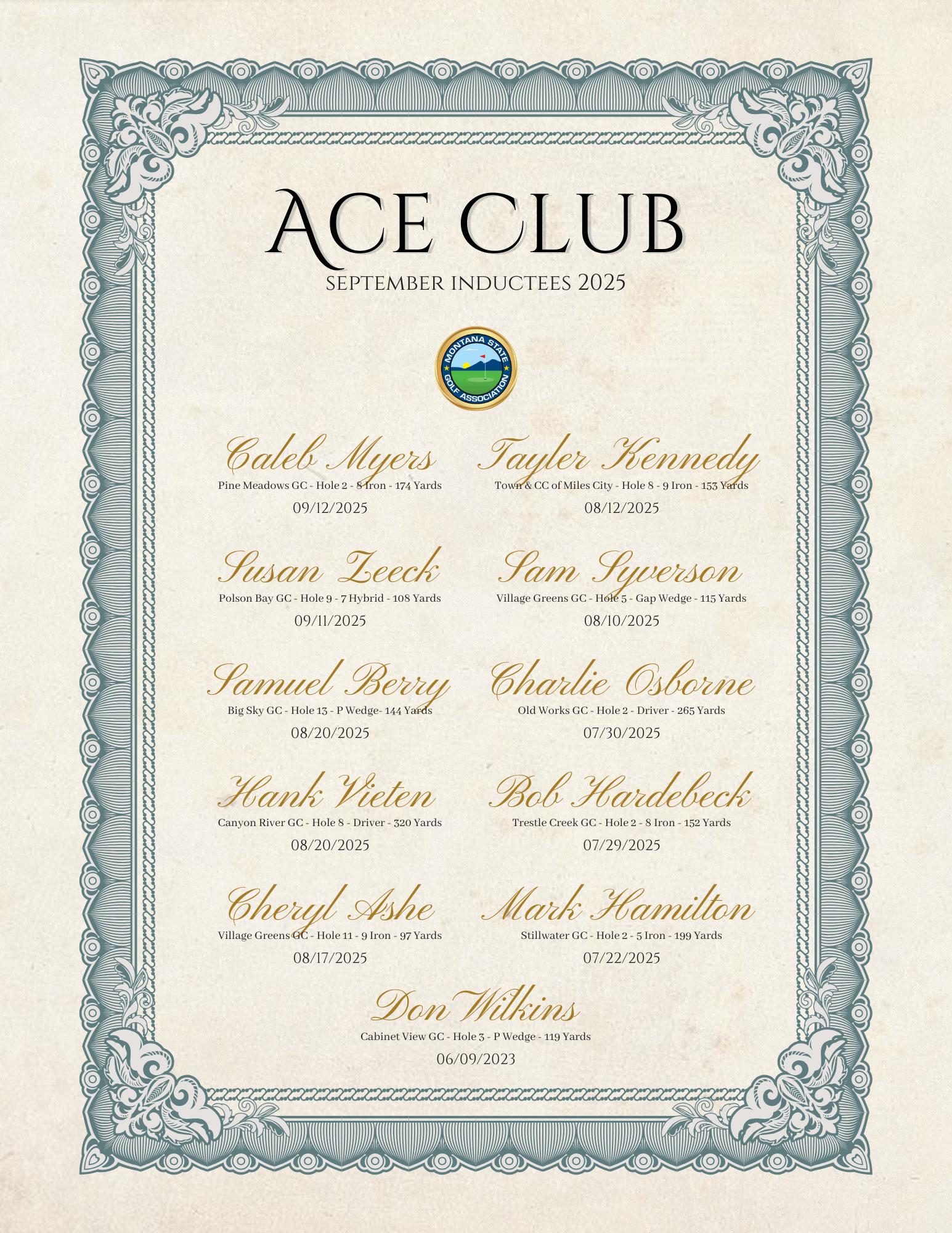
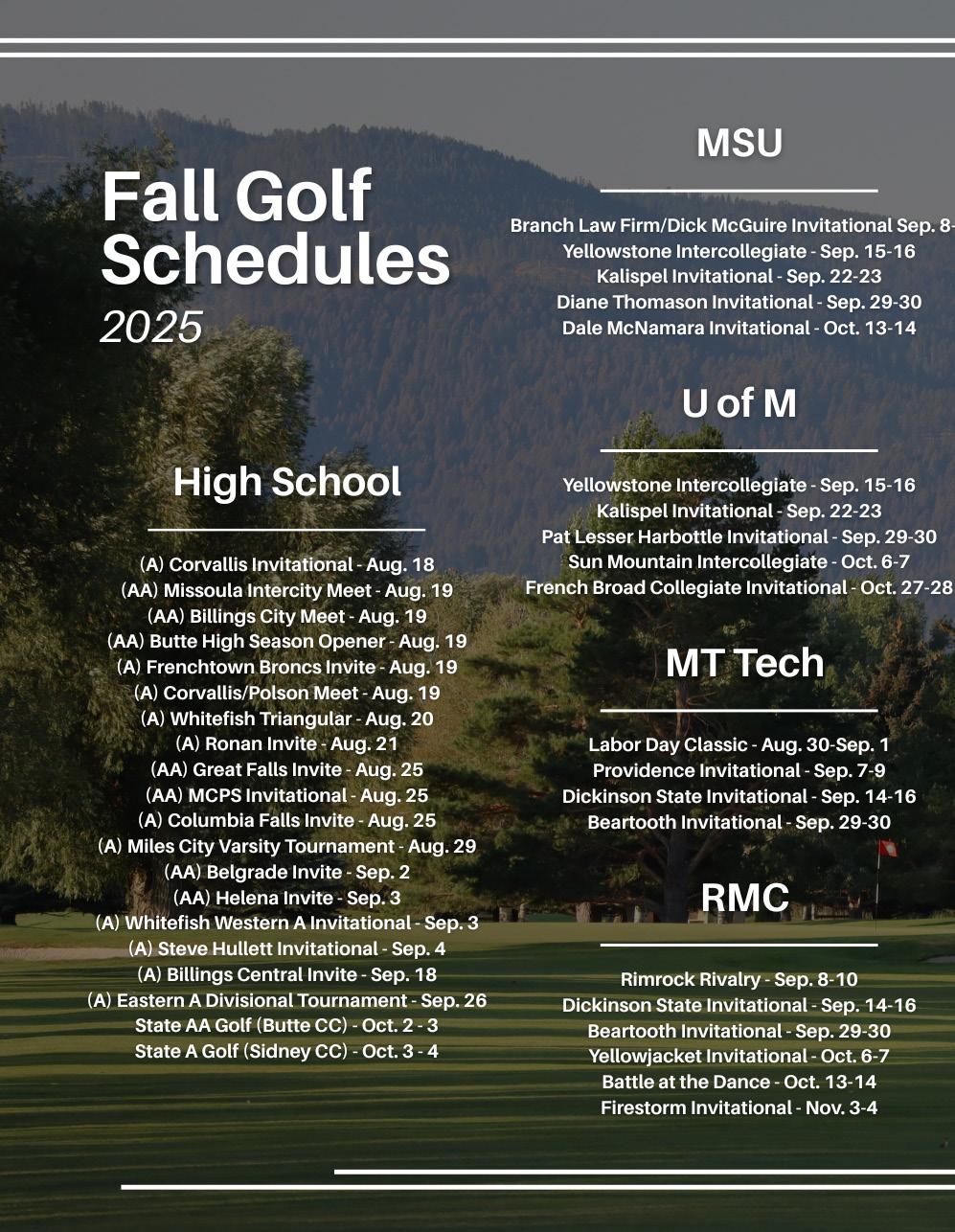
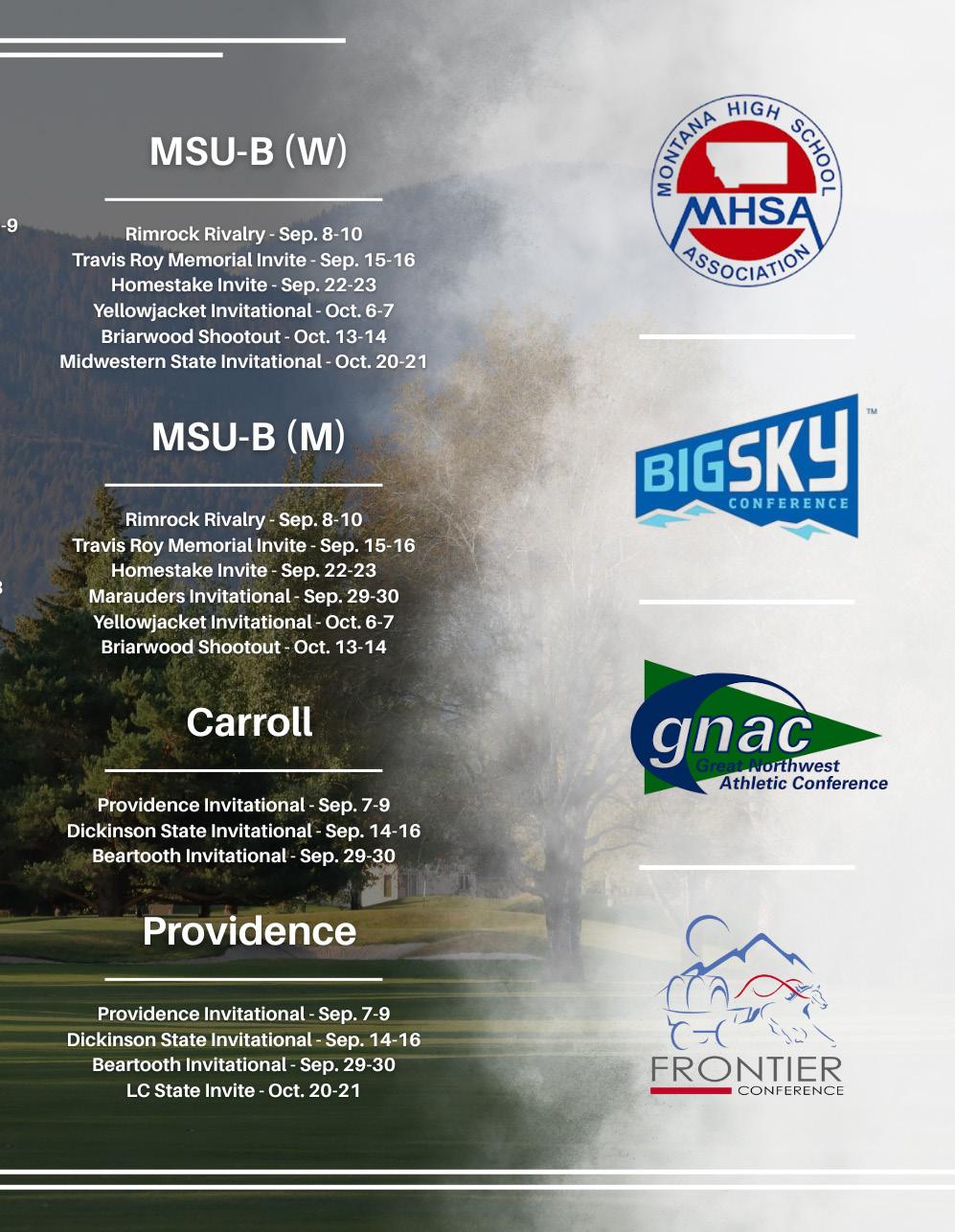

BY TY SPARING MSGA COMMUNICATIONS COORDINATOR
There was a Big Sky Conference rendezvous at the Ranch Club recently as the University of Montana hosted the first conference event in Missoula since 2013. Six teams
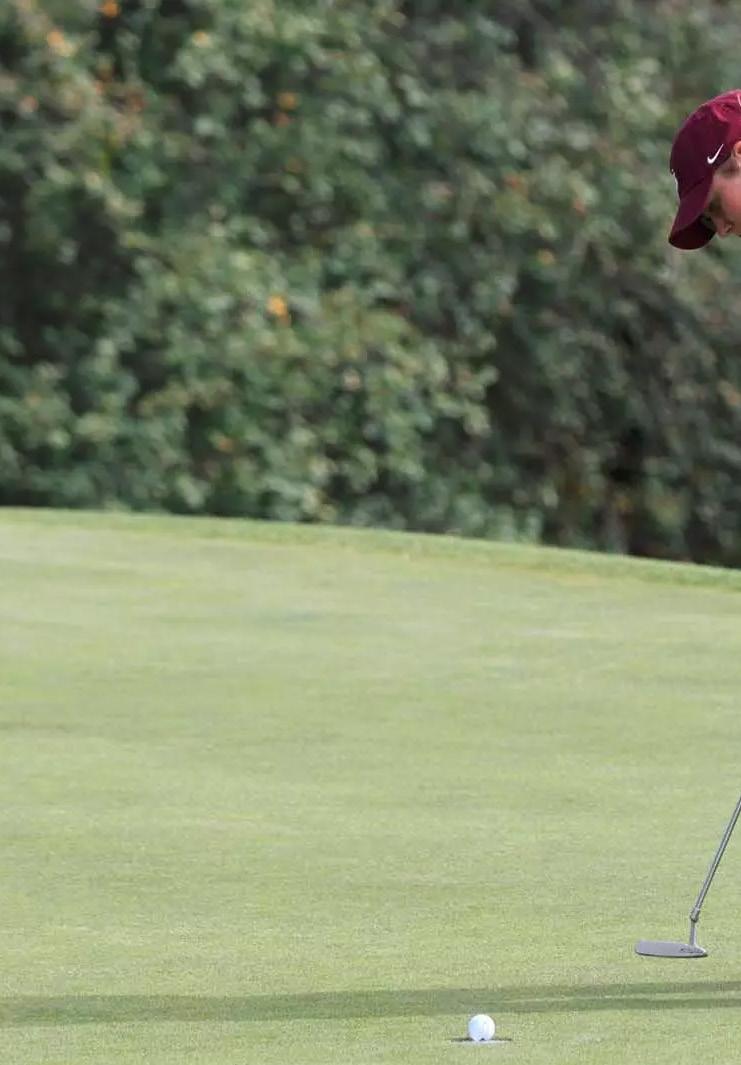
and a handful of golfers playing as individuals made the trip up to play three rounds in our beautiful state.
Leading the Montana contingent of golfers was Montana State’s Ashleigh Wilson who was one of those playing as an individual. She finished in a tie for second place at +1 (217). The freshman Wilson scored increasingly better as the days went on and kept herself within reaching distance of the top spot until the end.
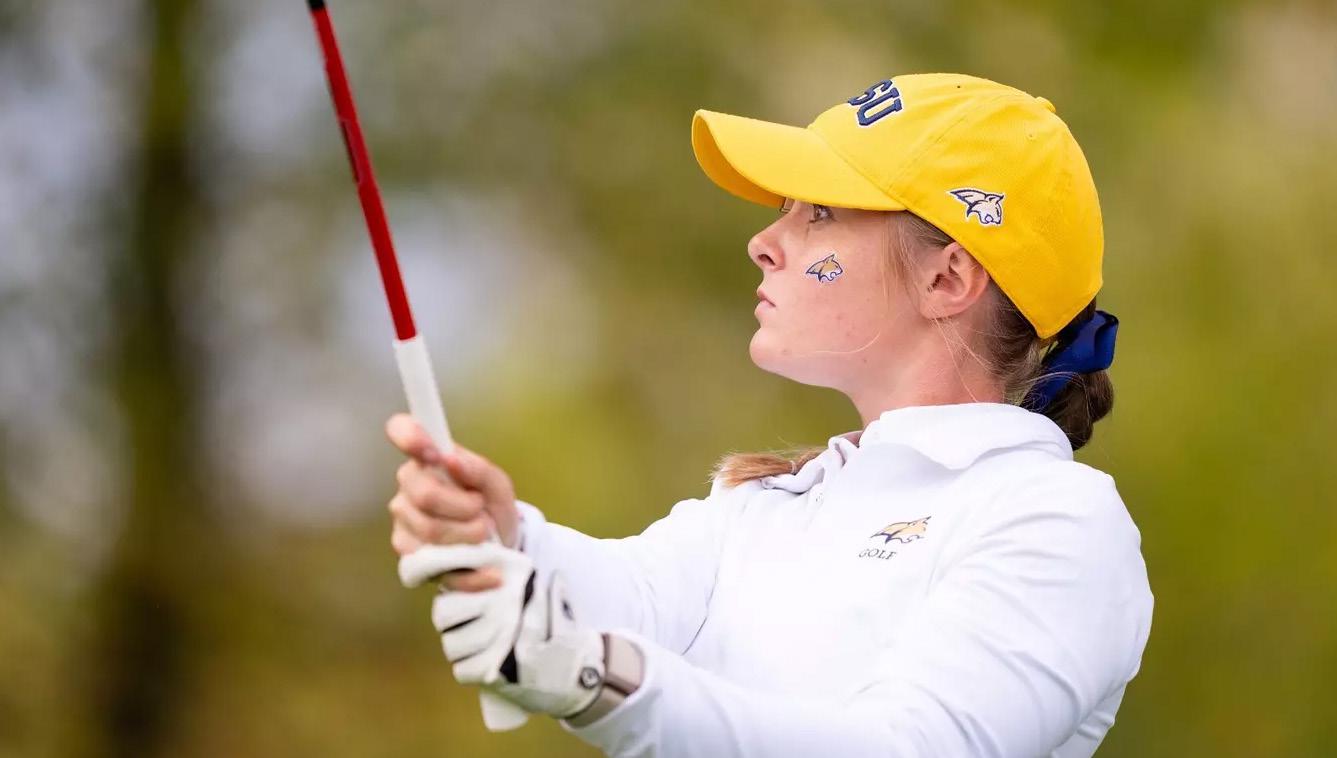
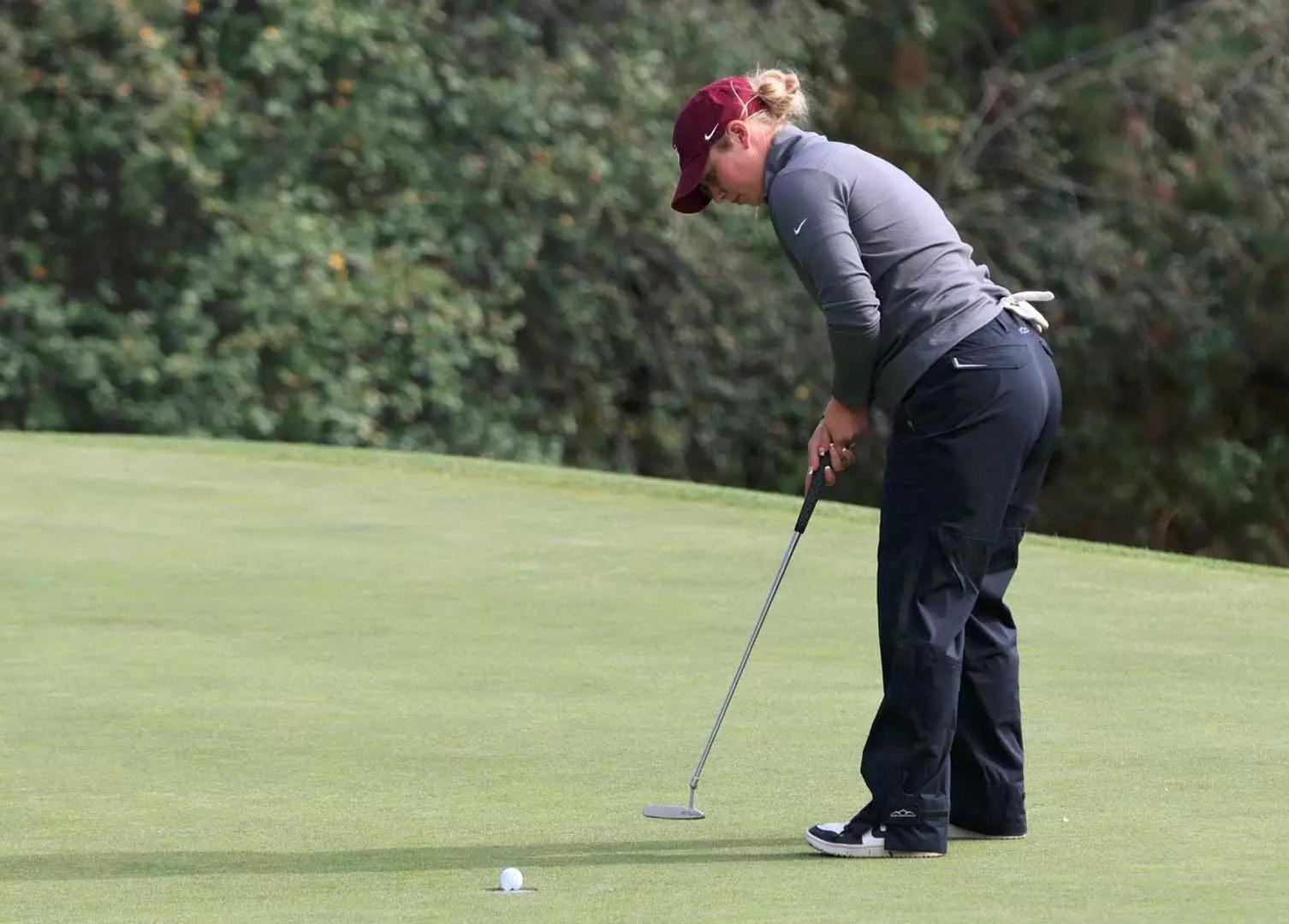
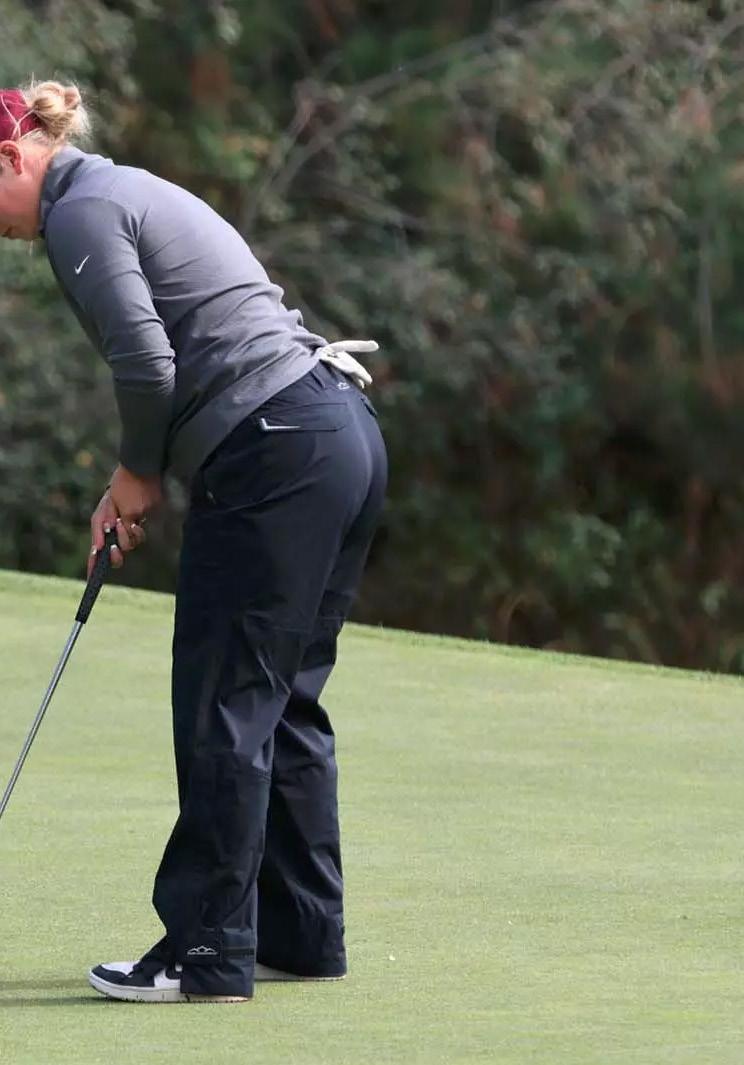
Sophomore Bella Johnson meanwhile led the way for the Griz, finishing in a tie for seventh place at +4 (220). For the former twotime Montana Class AA High School champion at Billings West, Johnson continues to develop into one of UM’s top golfers.
Joining Wilson and Johnson in the top half of the field was MSU’s Sailor Graham who tied for fifteenth at +8 (224) and University of Montana’s Hanna Ports who ended up in nineteenth place at +10 (226).
Weber State won the team event at +16 (880) overall and also produced the individual champion in Braylyn Bayer who won the event at -2 (214).
For full results of the Sun Mountain Intercollegiate, CLICK HERE
The Lake Hills Golf Course in Billings recently hosted the Yellowjacket Fall Invitational, in which both men’s and women’s MSU-B teams, along with the squads from Rocky Mountain College, were competing over two rounds against full fields of competitive golfers. Held October 6-7, it was another strong Battlin’ Bear performance with two team victories and one individual title.
RMC’s Aidan McDonagh led the way on the men’s side of things, tying for first place at -1 (143) with University of Mary team-
mates Lucas Schoepp and David Thomson. McDonagh was joined in the top ten by freshman Sam Norman who tied for seventh at +1 (145) and there was a logjam of players that tied for ninth at +3 (147), including Battlin’ Bears Adam Hyde-Lay and Kristjan Burkelca
The Yellowjacket men were led by Pete Netrnilweerachot who tied with Norman for seventh and Ryder Conner who was part of the group that tied for ninth place.
Rocky won the team event by seven strokes over the University of Mary Maruaders with a final two round score of +5 (581).
On the women’s side MSU-B’s Orraya Tipasathien continued her record-breaking collegiate career by finishing runner up by one stroke with a final score of +7 (151). Following Tipasathien was a pair of RMC team-
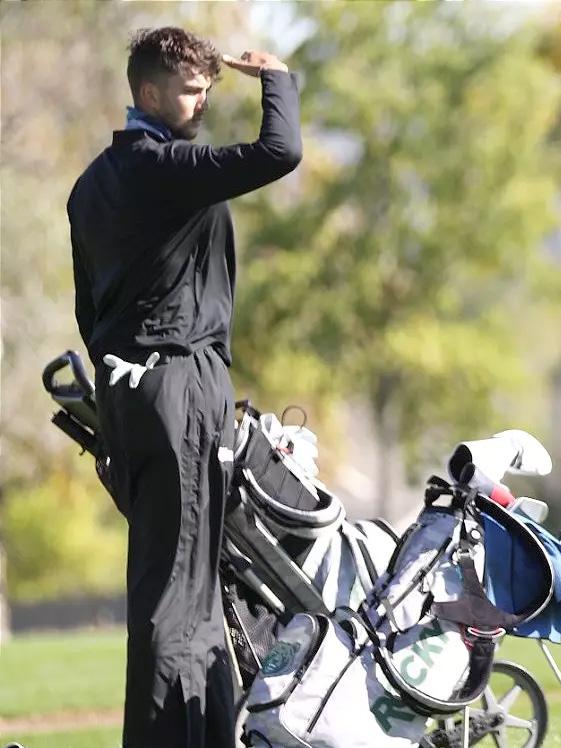
mates, Grace Metcalf and Kirsten Smith who tied each other at +10 (154).
In fifth place was MSU-Billings’ Ella Tannenberger with a score of +11 (155), RMC’s Kadence Fischer finished in seventh at +13 (157) and Tyla Potgieter (RMC) and Hanna Boyd (MSU-B) ended up in a tie for tenth at +17 (161).
Chadron’s Macy Kleve won the individual title by one stroke over Tipasathien, with a final score of +6 (150).
With a top ten littered with names from both schools, Rocky Mountain managed to overtake the Yellowjackets by five strokes on the women’s side, to win the team event at +50 (626).
For full results of the Yellowjacket Fall Invitational, CLICK HERE
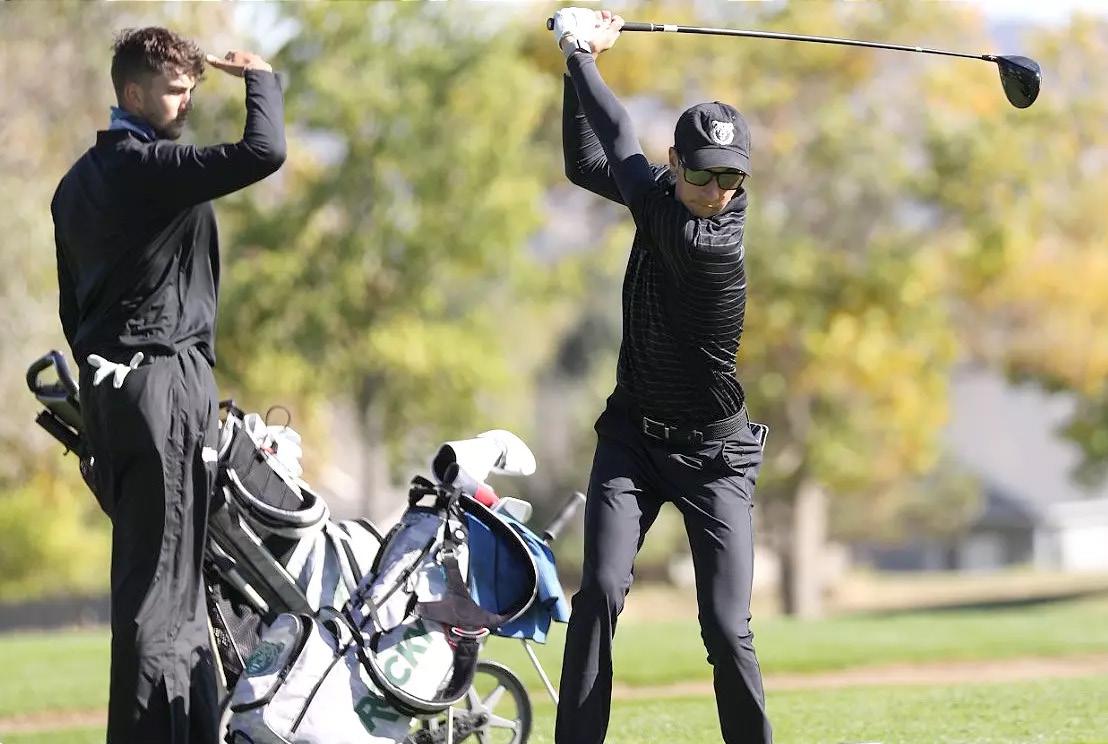
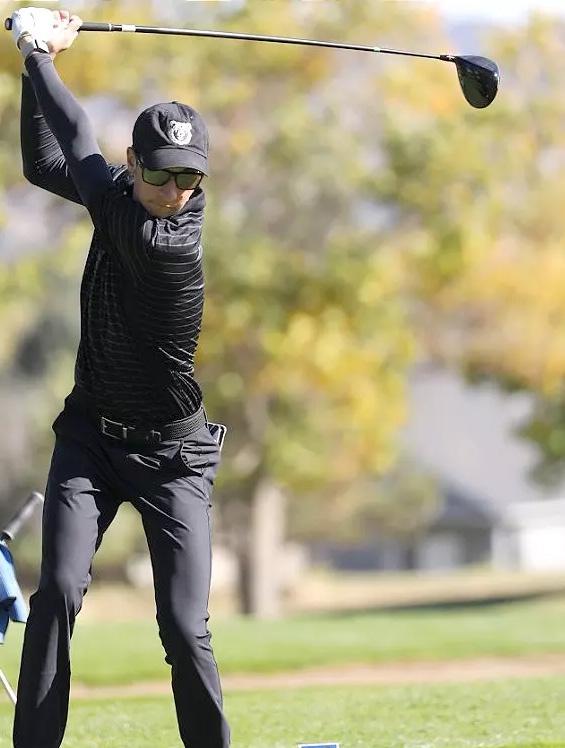

BY TY SPARING
MSGA COMMUNICATIONS COORDINATOR
Class A competitors traveled east for their state tournament. Held October 3-4, golfers were all the way over at the Sidney Country Club for two rounds of play.
If the boys’ Class A narrative has been all about Corvallis’ Brady Powell and Polson’s Max Milton this year, Billings Central’s Colin Jensen had other things to say about that in Sidney as he cruised past the competition on day two to win the event by three strokes over teammate Caleb Fornshell.
Coming into the second day down six strokes behind the leader and last year’s Class A champ Max Milton, Jensen caught fire with a single round score -6 (66) that included seven birdies. It was on the back nine that Jensen really caught fire, posting five birdies in the span of seven holes and just like that the Rams golfer had a three-stroke cushion and his first state high school title.
For those who have been following, Jensen’s success should come as no surprise. This past summer the sophomore was part of
a Boys Junior America’s Cup team that also consisted of the 2025 Montana State Junior Champion Brady Powell, the 2025 Class AA champ John Gilbert and the 2024 Class A champ Max Milton.
While the Billings Central duo of Jensen and Fornshell finished 1-2 in the standings, third place was a tie between Powell and Milton at +1 (145), while fifth place went to Park High’s Sawyer Gentry at +3 (147).
Despite the Rams having the top two spots, the Corvallis boys team was able to sneak past for the victory by two strokes. Along with Powell in third place, they also had Dylan Wirt finish in seventh place at +6 (150) and Tag Jessop tied for ninth at +9 (153). Polson finished in third at +61 (637).
After finishing runner up last year, Park High’s Anna Lende found herself in the top spot after two rounds, claiming the individual Class A title by eight strokes with a final score of +10 (154). Her back-to-back rounds of 77 were the two lowest individual scores of the tournament.
Following Lende was Billings Central teammates Jordan Nielsen and Berkley Park who finished in first and second place with respective scores of +18 (162) and +19 (163). In fourth was Whitefish’s Karlee Brown at +20 (164) and taking the fifth spot was Dillon’s Skylar LaPierre.
The Billings Central girls team was the only repeat champion in either Class AA or

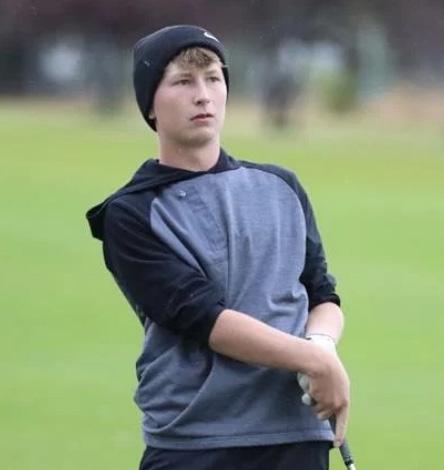
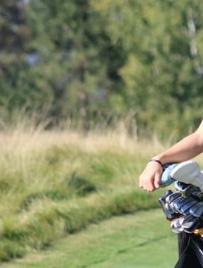
Class A this 2025 fall season. Along with Nielsen and Park, the Rams placed two more golfers in the top ten, as CeCe Fornshell and Kaitlin Ferris tied for eighth place at +37 (181).
For full results of the Montana State Class A High School Tournament, CLICK HERE
After qualifying in the earlier divisional rounds, high school golfers from around the state made their way to the historic Butte Country Club for the final competition of the fall season, the Montana State Class AA High School Tournament. The two-round event was held October 2-3, with an all-new slate
of champions crowned for 2025.
There was a little drama on the boys’ side of things, as Capital High’s John Gilbert and Missoula Sentinel’s Jack Schaefer found themselves tied at the end of regulation, but after three playoff holes it was Gilbert who was crowned with the individual state title for 2025. The two golfers shot identical rounds of 72-69, and after two playoff holes in which they both bogeyed and then parred, Gilbert managed to sink a birdie putt, giving him the slight edge over his Spartan counterpart who bogeyed the hole.
For the junior Gilbert, it’s a bit of redemption after narrowly missing out on the 2025 Montana State Junior Championship back in June. Similar to the Class AA State Tournament, Gilbert was tied with Corvallis’ Brady Powell at the end of the three-round event but unlike in Butte he lost in the first playoff hole.
A state title wasn’t the only good news for Gilbert, who just a couple days before the state tournament began, had officially

committed to play golf for Washington State University.
Following Gilbert and Schaefer on the leaderboard was CMR’s Jack Pinski who finished in third place at +4 (144), and rounding out the top five was a tie for fourth place at +10 (150) between Austin Kaufman (Helena High) and Derek Schaefer (Sentinel).
Missoula Sentinel won the boys’ team event by fifteen strokes over Capital High with a final two round cumulative score of +36 (596). Along with the Schaefer brothers, the Spartans also had two other golfers finish in the top ten: Willy Nowlen in ninth place at +13 (153) and Joseph Meusey tied for tenth at +14 (154) with Capital’s Reece Chapman.
On the girls’ side it was another Billings Senior individual champion, as Payton Tryan ran away with the title by seven strokes with a final score of +11 (153). The junior Tryan was the only competitor to record a single round score under 80, doing it both days at 76 and 77. Tryan joins a prestigious list of former Broncs who have won state titles the
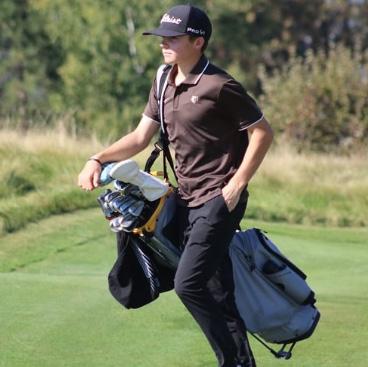
last few years with Becca Washington who won last year and Kenzie Walsh who won the title in 2023.
If you add Bella Johnson’s two state titles for Billings West that preceded Walsh’s victory, the city of Billings has claimed the last five individual Class AA girls’ titles.
Following Tryan was a pair of Bozeman teammates, with Heidi Huber finishing in second at +18 (160) and Kira Connell in third at +20 (162). Gallatin’s Breckin Frederick ended up in fourth place at +25 (167) while Avery Garden (Bozeman) and Lilia Troxel (Belgrade) tied for fifth place with final two round scores of +27 (169).
With three competitors in the top five, Bozeman High ran away with the girls team event, winning by 35 strokes with a final score of +121 (689). In second was Billings West at +156 (724) and in third was Gallatin at +191 (759).
For full results of the Montana High School Class AA State Tournament, CLICK HERE
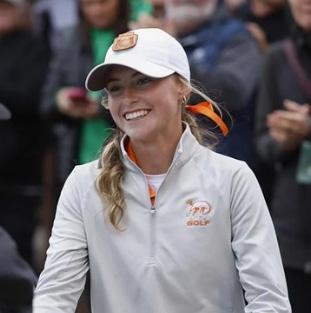
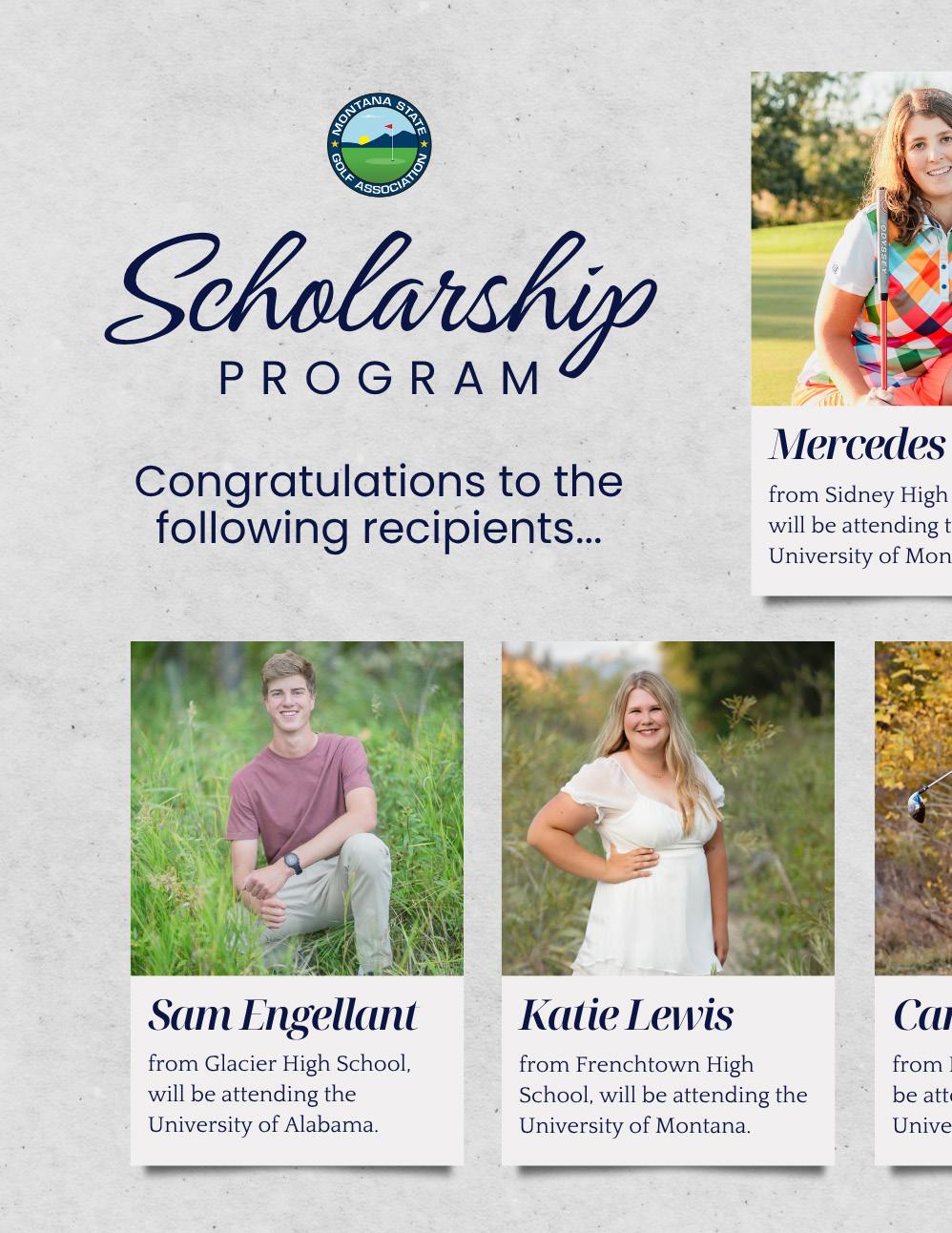
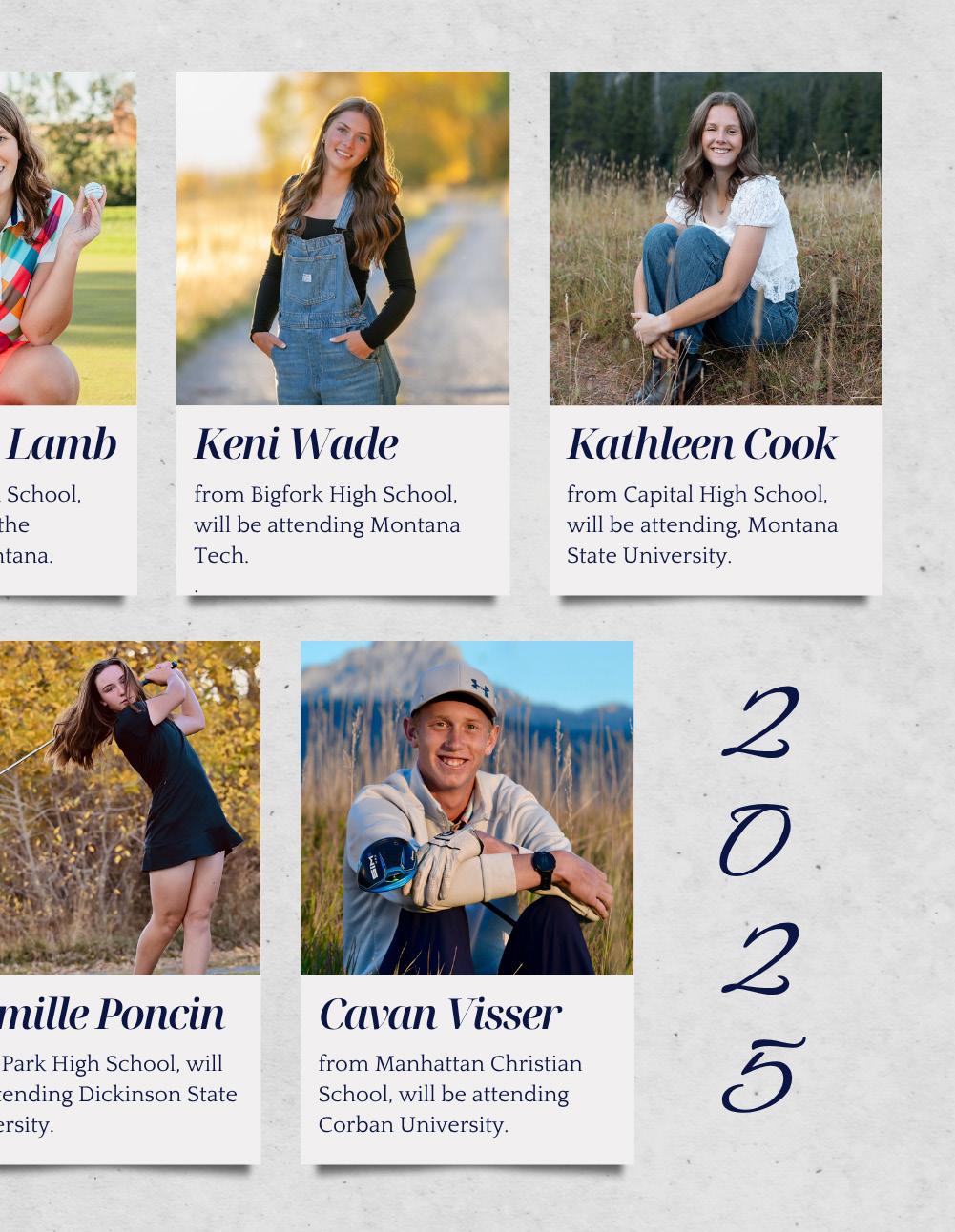
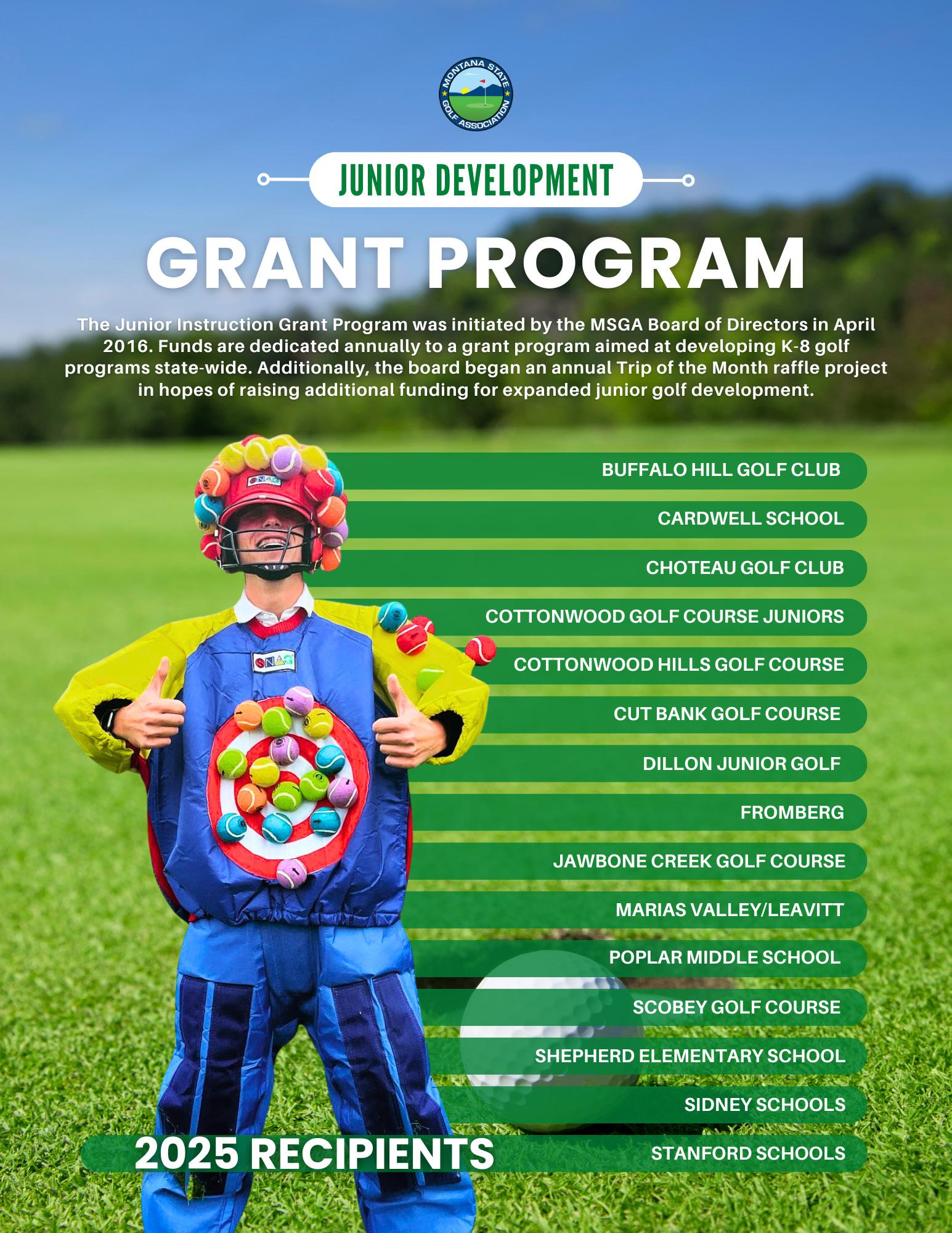
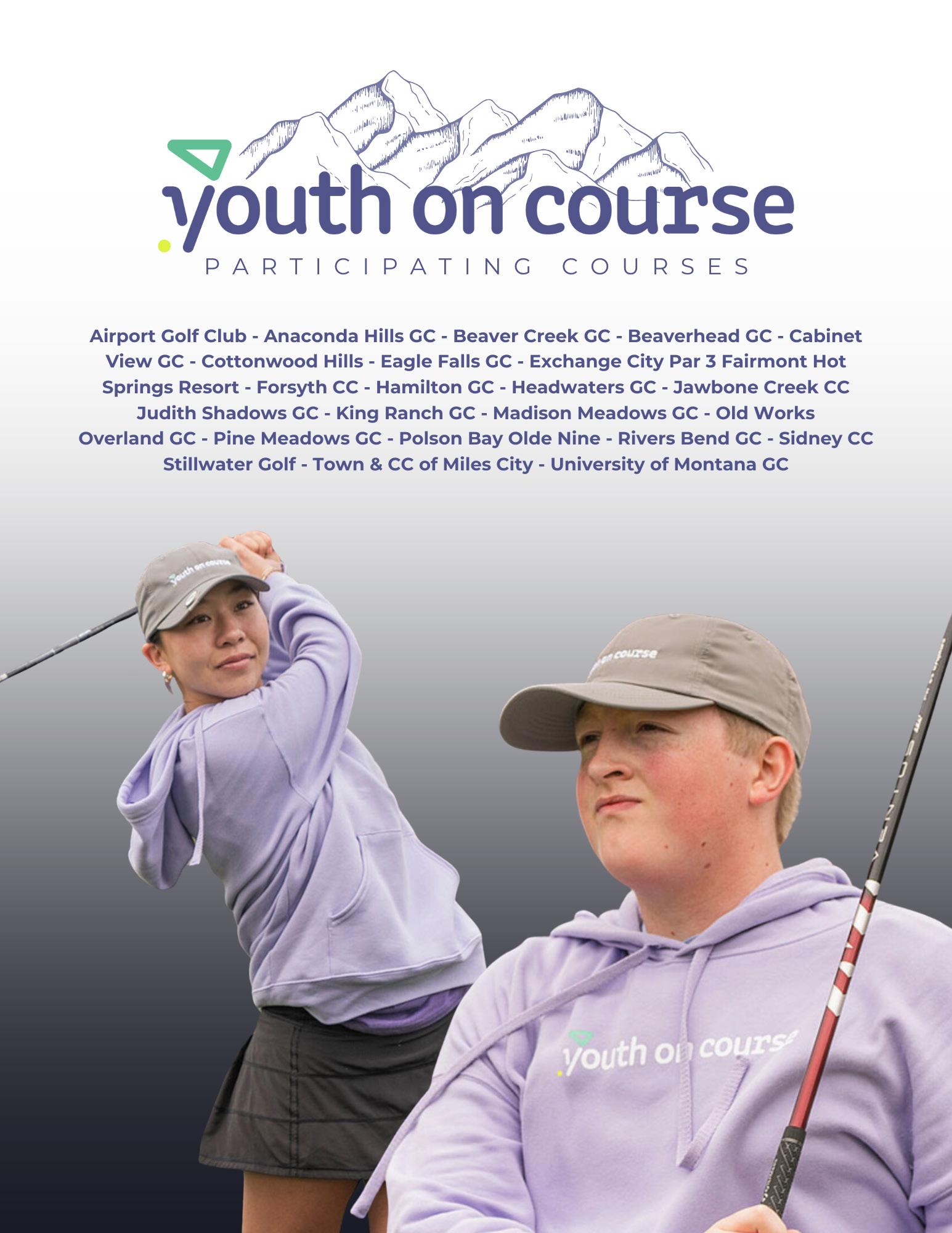

BY LOGAN GROENEVELD-MEIJER
Originally published in PNGA News
In forming thoughts about Alaska, it’s possible that snow-capped mountains, polar bears and the Iditarod come to mind before golf does, given the state’s well-known winter climate.
But opposite Alaska’s wicked winter months are those of its predominantly daylit summer, which understandably bodes well with plans to tee it up. Throughout a short but thoroughly seized three months of the year, college-level talent is still more than capable of originating up north, even in an absence of high school programs.
Exemplary players Abigail Ante and Jack Carr, both of Anchorage, play for the University of Missouri-St. Louis and Willamette University programs, respectively. It was at Anchorage Golf Course in Alaska’s big city where both players earned their stripes after being introduced to the game by their fathers.
Having just completed her redshirt freshman season, Abby recalls, “I just started going to the range with my dad; he’s the one who started working with me,” adding that most golf outings in high school simply added up to “a bunch of kids goofing off on the course,” given Alaska’s lack of widespread junior tournaments.
As college golf became Abby’s “biggest dream ever,” she found herself working at that course in her hometown and took full advantage of her access to it during the fleeting summer seasons.
“I would make sure to, after I clocked out, just hit balls and live on the course all the time,” she said. “I remember playing until 1:00am sometimes.”
Jack’s dad, himself an avid golfer, wasted little time lending his skills to his sons.
“He just took us along and let me and my brother play as much as we wanted,” Jack said. “We got addicted.”
Both players’ trophy cases filled up quickly as their junior careers progressed. Abby won the 2020 Alaska Amateur Match Play and 2021 Anchorage Open, to go with a pair of runner-up finishes in the Alaska Women’s Amateur Championship. Jack took home the Alaska Men’s Amateur title in 2022 before his Bearcat career.
When the time came to think about college sports, Abby, who will tell you she played every sport growing up, admitted her decision to pursue golf at that level was viewed as bold by her parents.
“It was definitely a hard decision,” Abby said. “Growing up in Alaska, golf is not the sport where you think, ‘Oh, I want to play that.’”
To that end, the resources available to fledgling players do seem one-of-a-kind. During the roughly nine months of a given year when local courses are inundated with snow, much of Abby and Jack’s practice work came at the Fox Hollow Sports Dome, a classic inflatable facility measuring only about 75 yards, shorter than most golf shots.
“I have a couple nets in my garage,” Abby
said about her off-season practice. “My dad tried to get a simulator for the garage from eBay or something. The greens here are not great until probably the end of July. It’s definitely hard, but it’s something I managed.”
Having a grandmother in California, Jack took advantage of visits there to improve his game. The dome began to serve him well during the early COVID-era days, when he arrived daily at noon to swing away, often while Abby was also there. When the late springs months of the year would finally roll around and seasonal conditions became mild, further lessons and practice got Jack closer to college golf talent.
“I started to really see a jump in my game; I started to see results,” Carr said. “I started to think, ‘Wow, I’m making good progress.’”

For both players, an inescapable reality was that traveling away from Alaska to most other U.S. states required traveling hundreds (if not thousands) of miles. Ante’s opportunity in St. Louis – a city some 3,700 miles from Anchorage – was made possible by coach Troy Halterman, who connected with her after a tournament in Las Vegas, Abby’s first of any kind outside Alaska.
Traveling to St. Louis in August 2023, Abby admitted Missouri’s humid and not-so-chilly summer weather took some getting used to.
“It was such a huge change,” she said. “I remember the first practice, it was like 100 degrees, and the humidity was all the way up. I got sunburned. Everyone was checking in on me, like ‘Alaska, you all right?’”
Two years into being shown the Show-Me
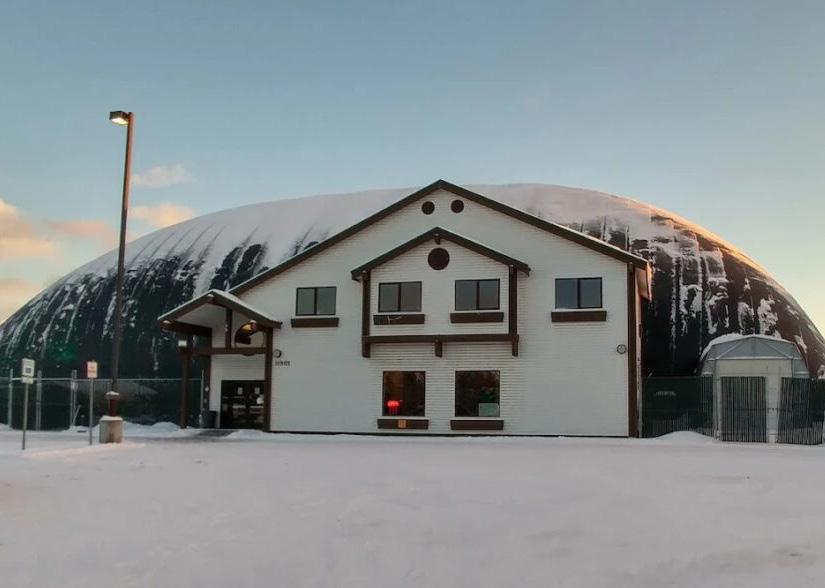

state, having seen a country club for the first time and caddying for baseball Hall-of-Famer and St. Louis Cardinals great Ozzie Smith during a fundraising event, Abby could hardly be happier.
“I think I could see myself living there,” she said happily. “Just the amount of friends I’ve made and the connections I’ve made, it’s just so great down there. I really love it.”
Jack, located in Salem, Ore., much closer to Anchorage and just a direct flight away, echoed Abigail’s positive words, and referred to his own adjustment as easy.
“I’ve made great, lifelong friends on this golf team,” Carr said. “It’s been nothing but a blast, and the coaches are very supportive.”
The special meaning of both players’ Alaska background isn’t lost on them either. Emotionally or strategically, small pieces of their home state factor into their lives today.
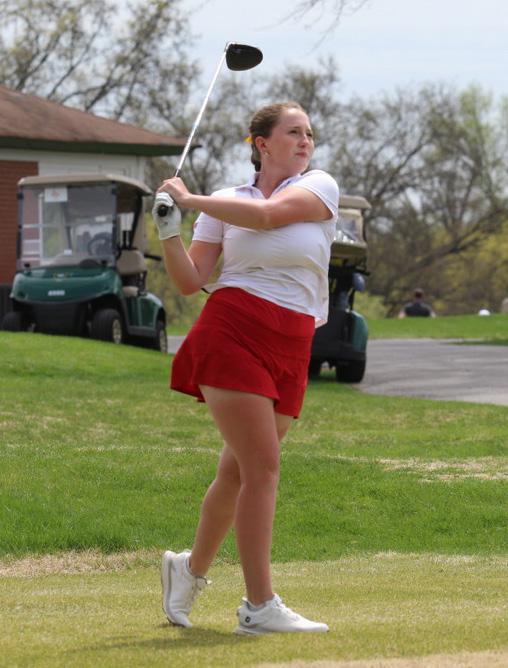
“If we’re playing on punched greens, like for a tournament or for a qualifier, well, punched greens are not too far from what greens are like right now in Alaska anyway,” Jack said. “It’s like I just feel like I can adjust, be more flexible and adapt pretty well, and go with what conditions I got.”
More recently, Jack also participated in the 100 Hole Marathon with members of the Alaska Golf Association, which he called “such a great group” given its tight-knit nature.
Abby is similarly appreciative of her home state, perhaps more so than she had been since her travels.
“When I say I’m from Alaska, people are like, ‘Wow,’” said Ante, whose teammates are used to playing year-round. “Sometimes I think I take for granted how cool this place is. Every time I come back, I realize how much I miss the mountains.”
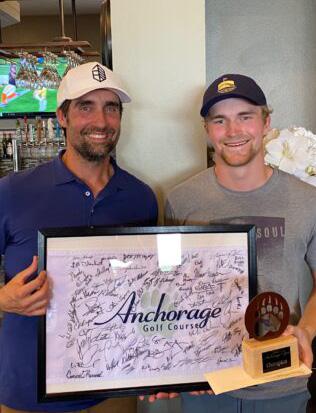


BY ROSS NIEWOLA AGRONOMIST, WEST REGION
Tree removal on golf courses is a common part of maintaining healthy turf and good playability. However, there’s a growing movement to leave high stumps – i.e., 6 to 12 feet tall – to benefit both the environment and the maintenance team.
High stumps provide ideal perching and nesting locations for birds of prey, such as hawks and owls. Encouraging raptors to patrol your course isn’t just environmentally sound, it’s also practical. Raptors are predators of ground squirrels and other turf-damaging rodents, offering a natural control mechanism that reduces the need for traps, poisons or other interventions. Rodents can cause extensive damage to playing surfaces, bunker faces and even irrigation wires, so a little help from local raptors is much appreciated by superintendents.
High stumping also saves labor and time. Cutting a stump to grade, grinding it, backfill-

ing the hole, and planting the area with sod or seed often requires specialized equipment and extra labor. With high stumping, staff can leave the stump intact and revisit it later if necessary. In many cases, these high stumps are left in naturalized areas where their visual impact is minimal, and their functional value is high.
This approach represents a smart intersection of sustainability and efficiency. Superintendents are finding that high stumping offers a low-cost, high-value solution that supports wildlife and eases the labor load. It’s a simple practice with wide-reaching benefits, a win-win for course management and the environment.
So, the next time a tree is ready to come down, think twice before cutting the stump all the way to the ground. Leaving a high stump might be just the invitation a raptor needs to take up residence and help out with some of your pest problems.
